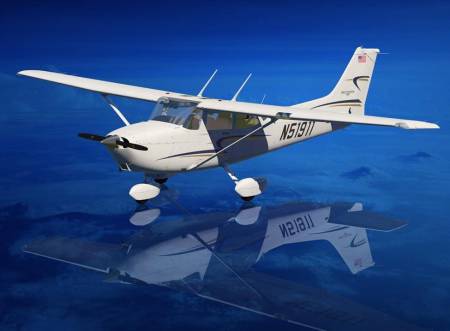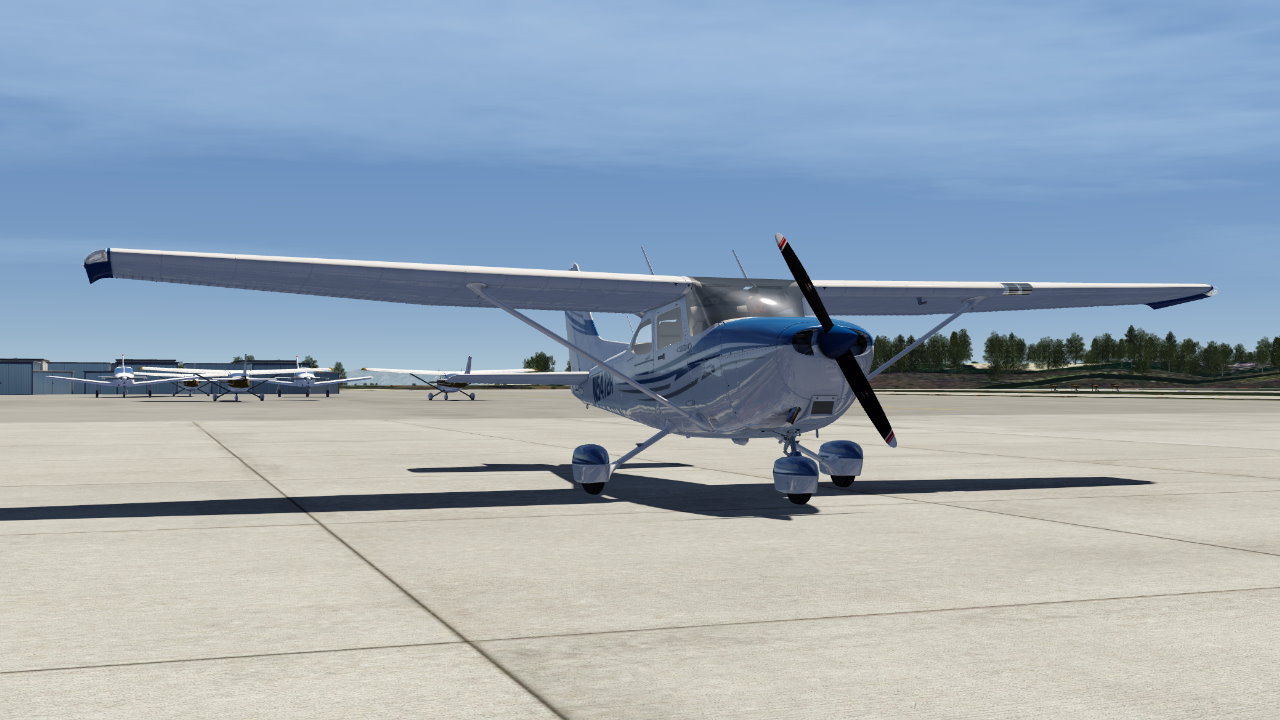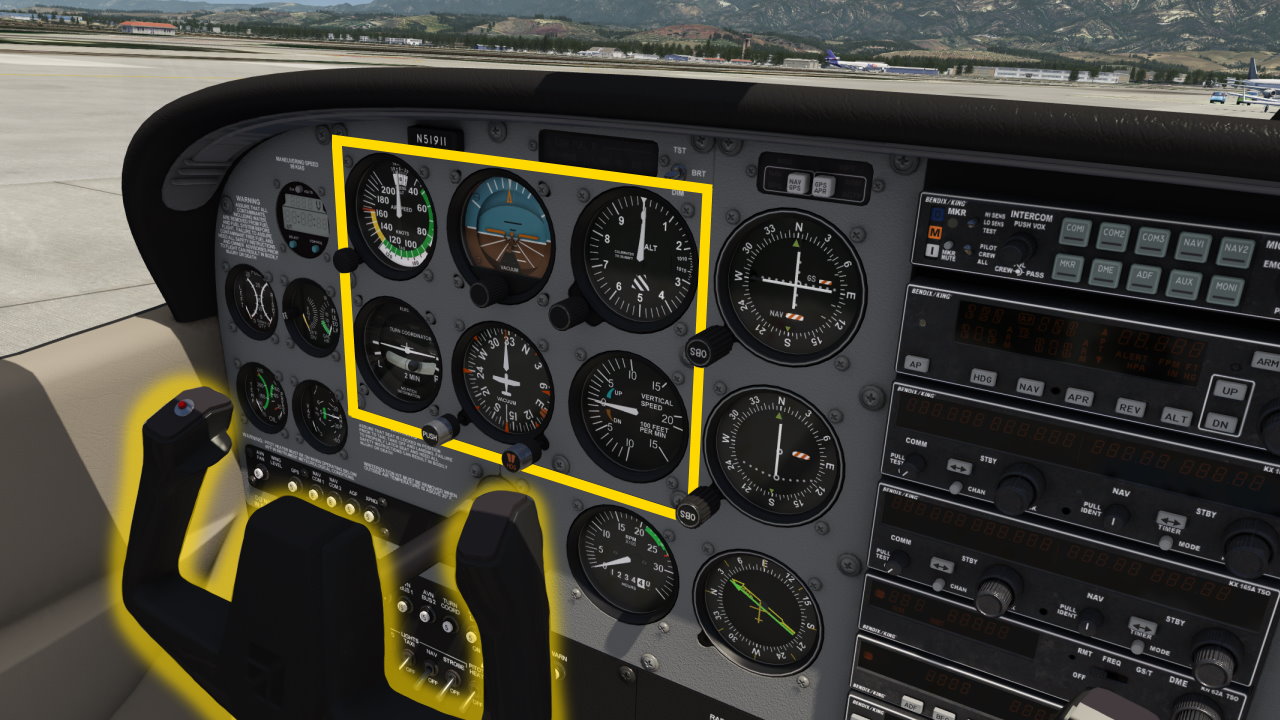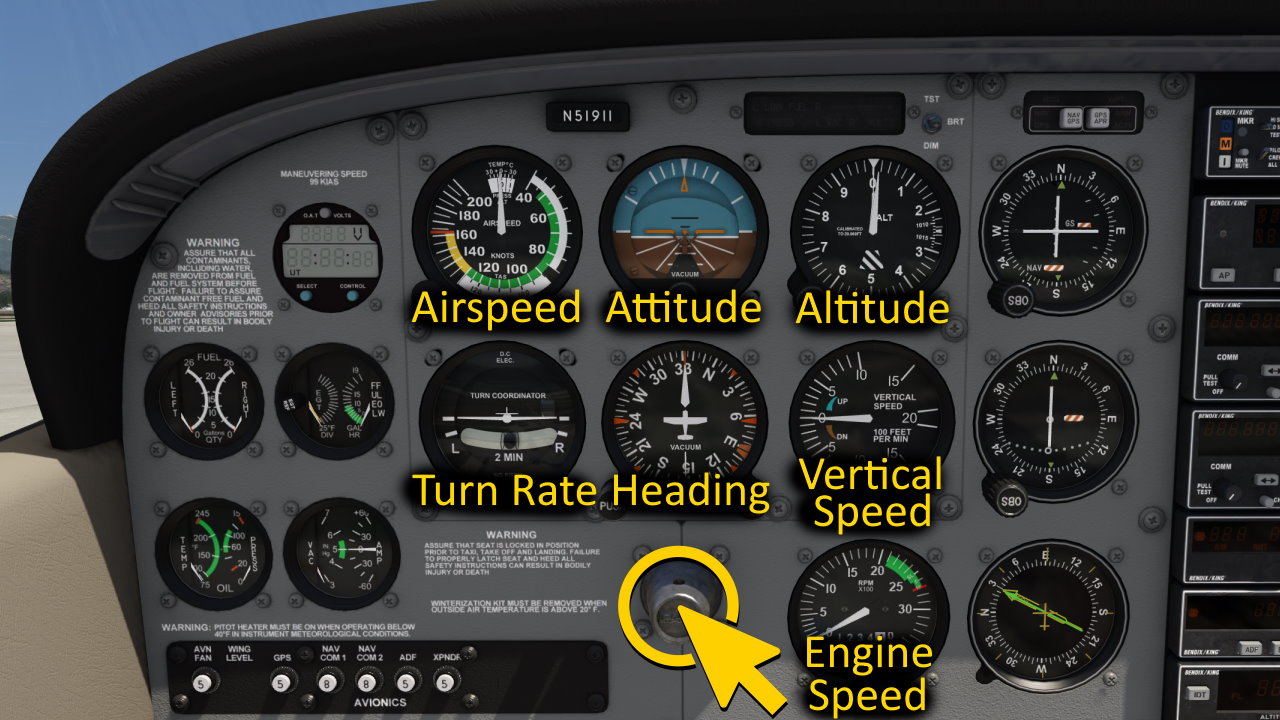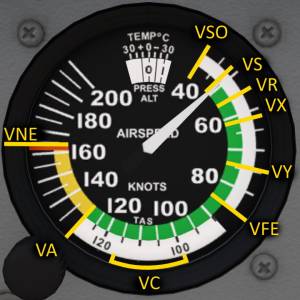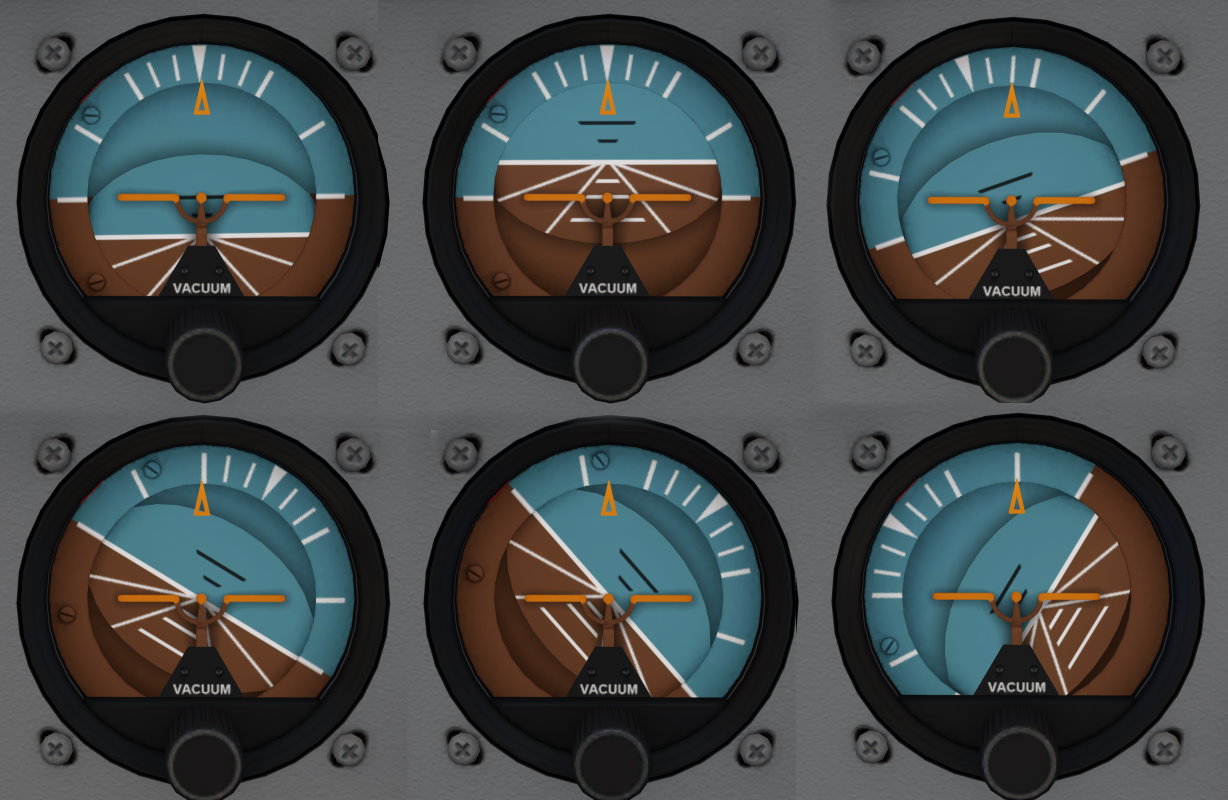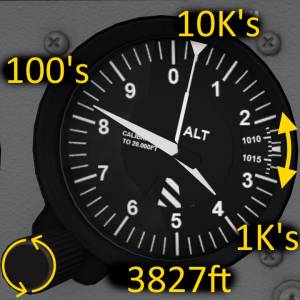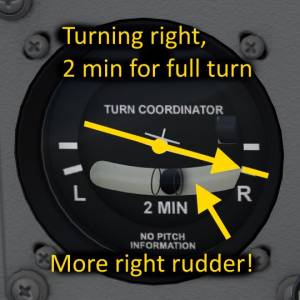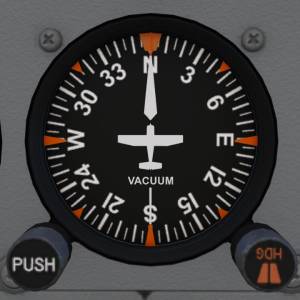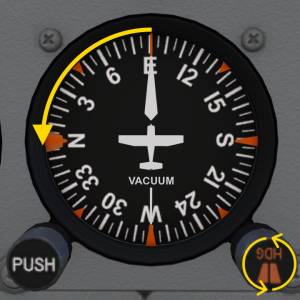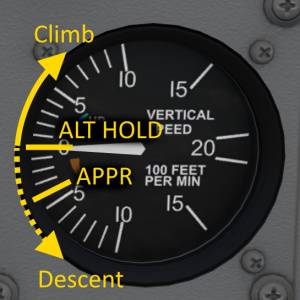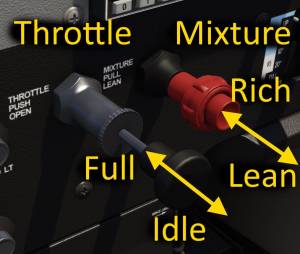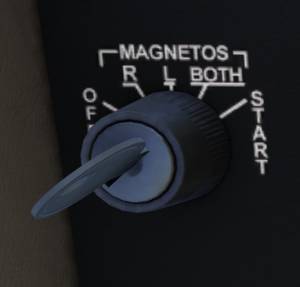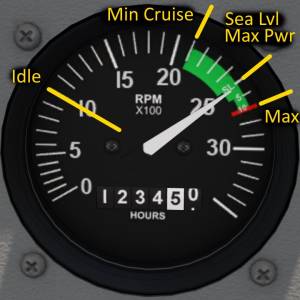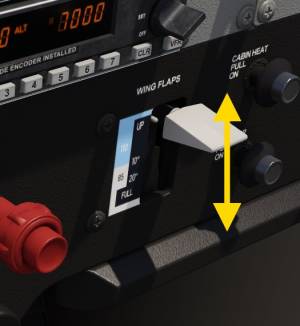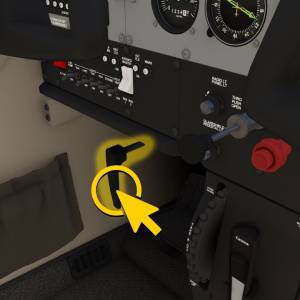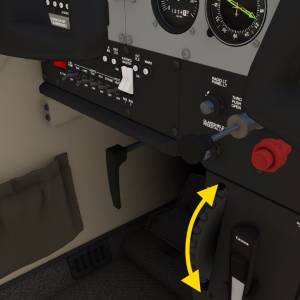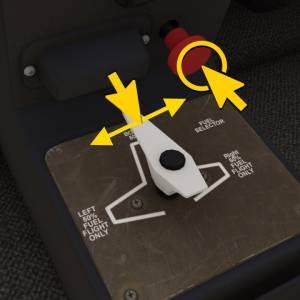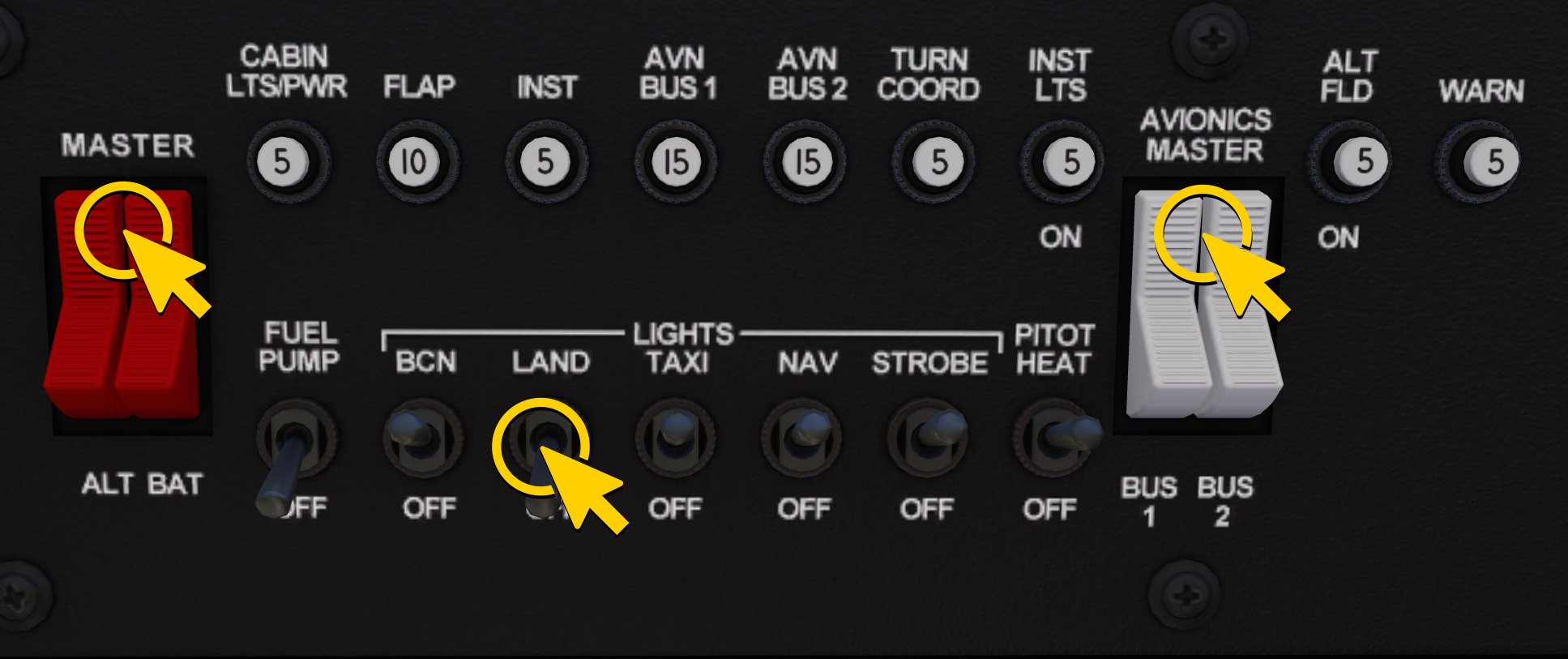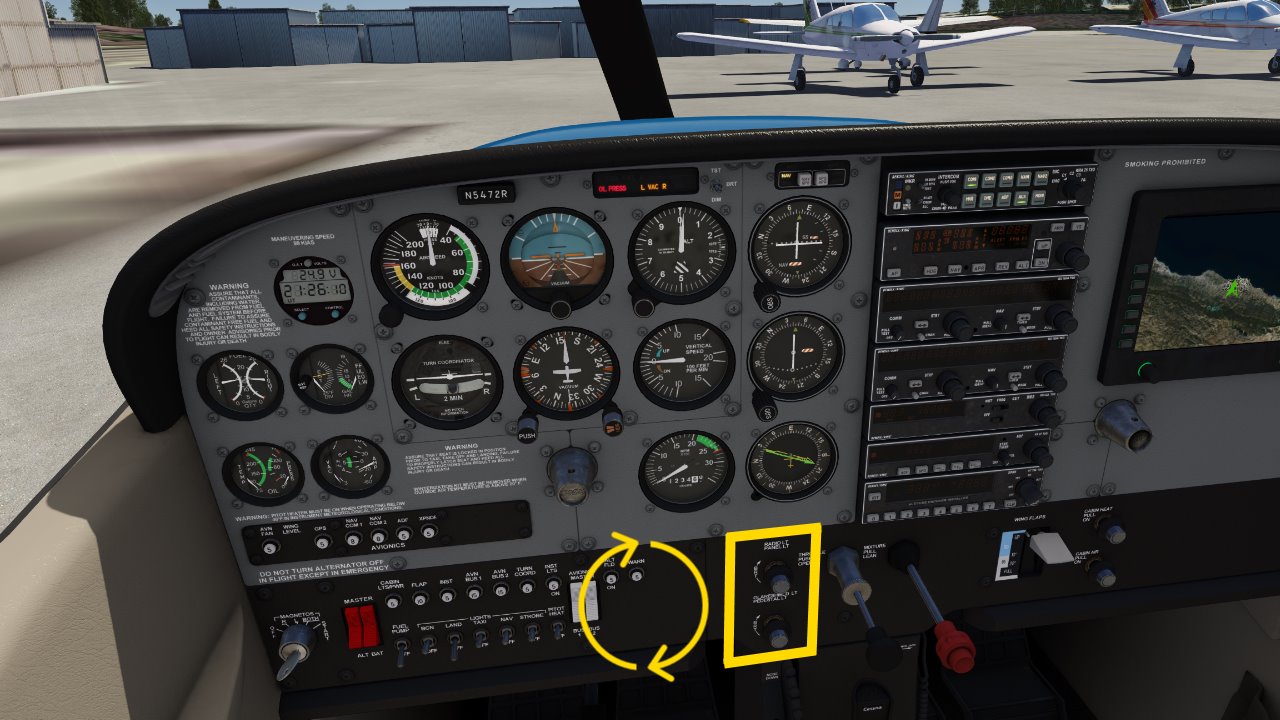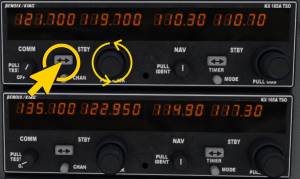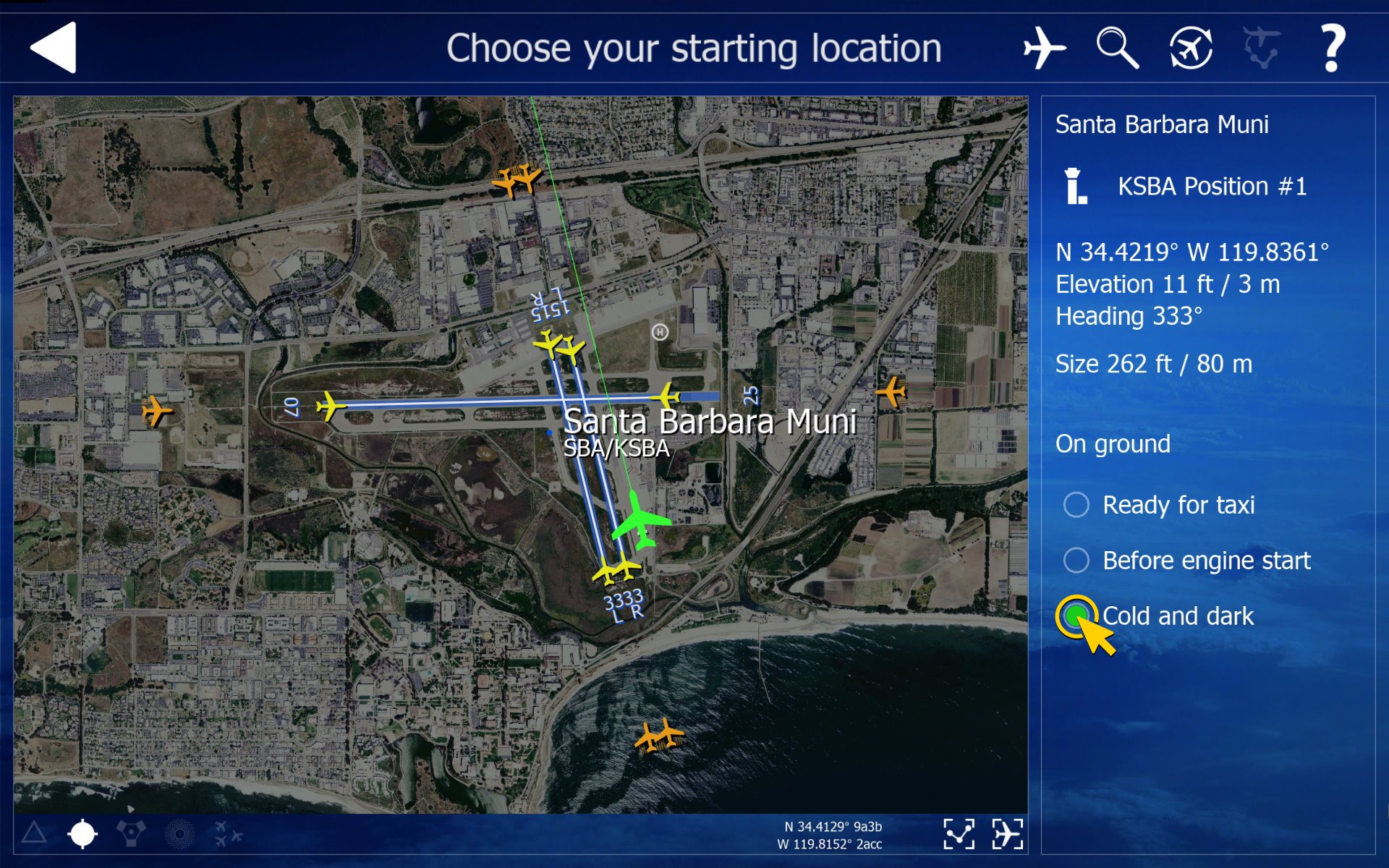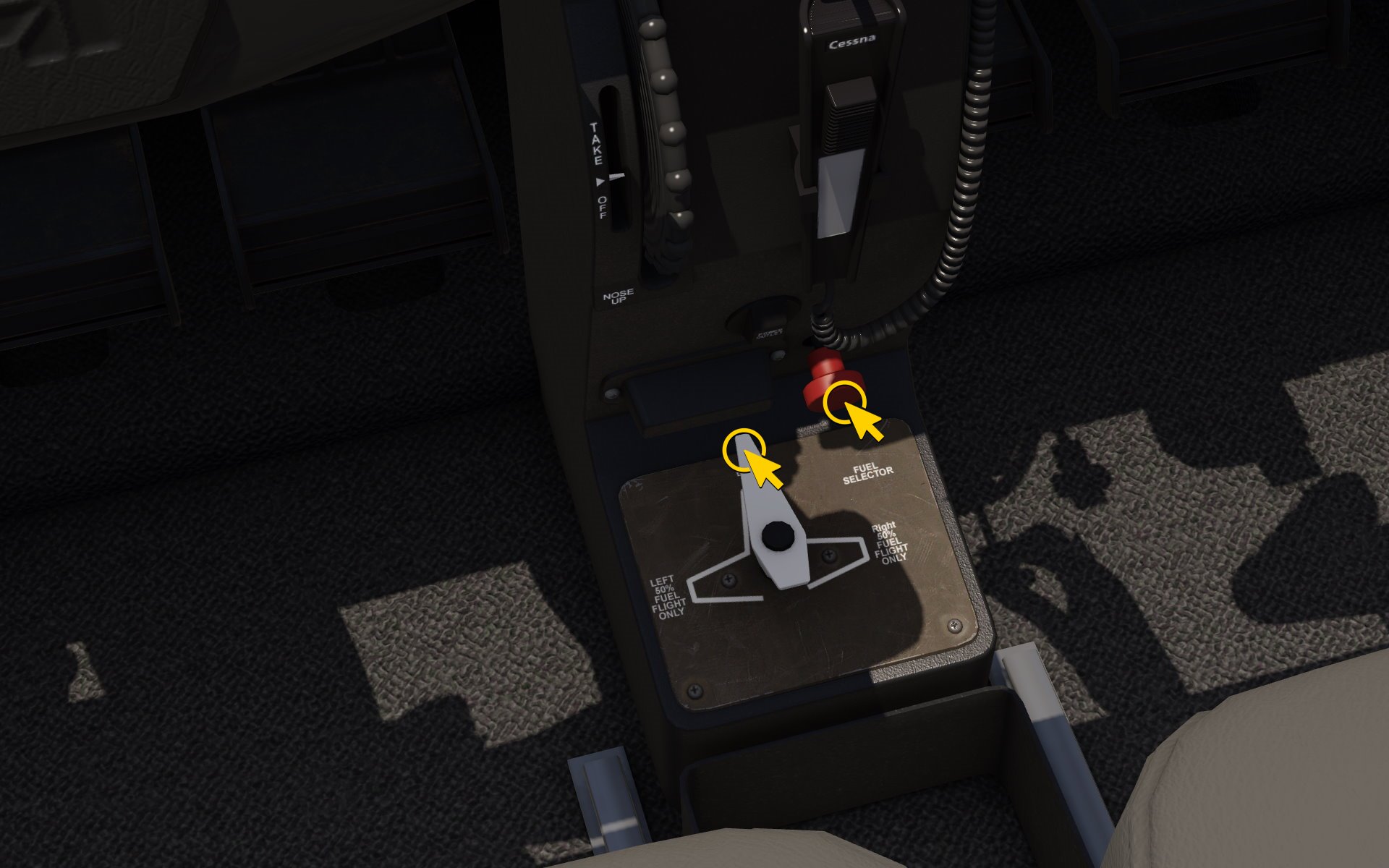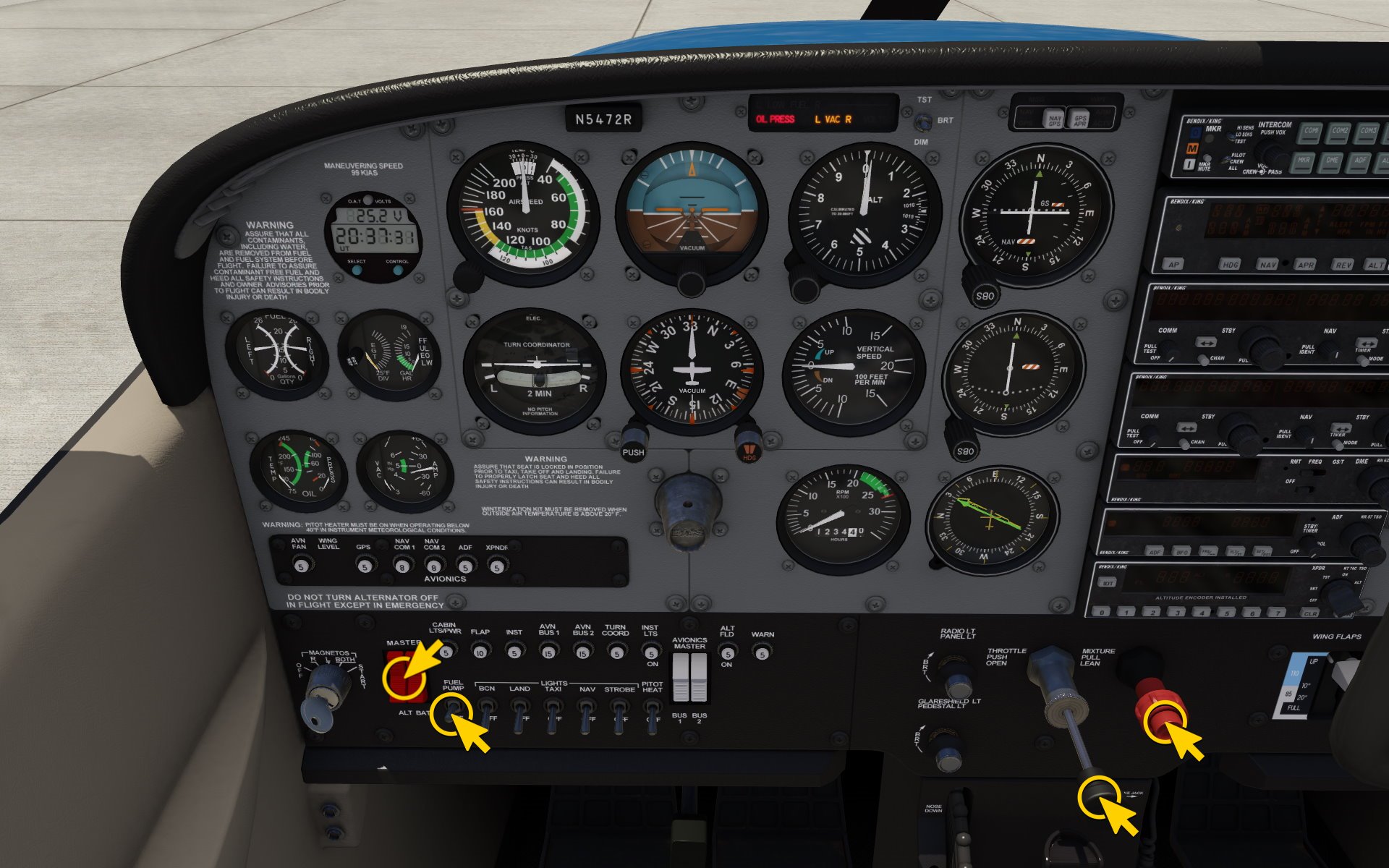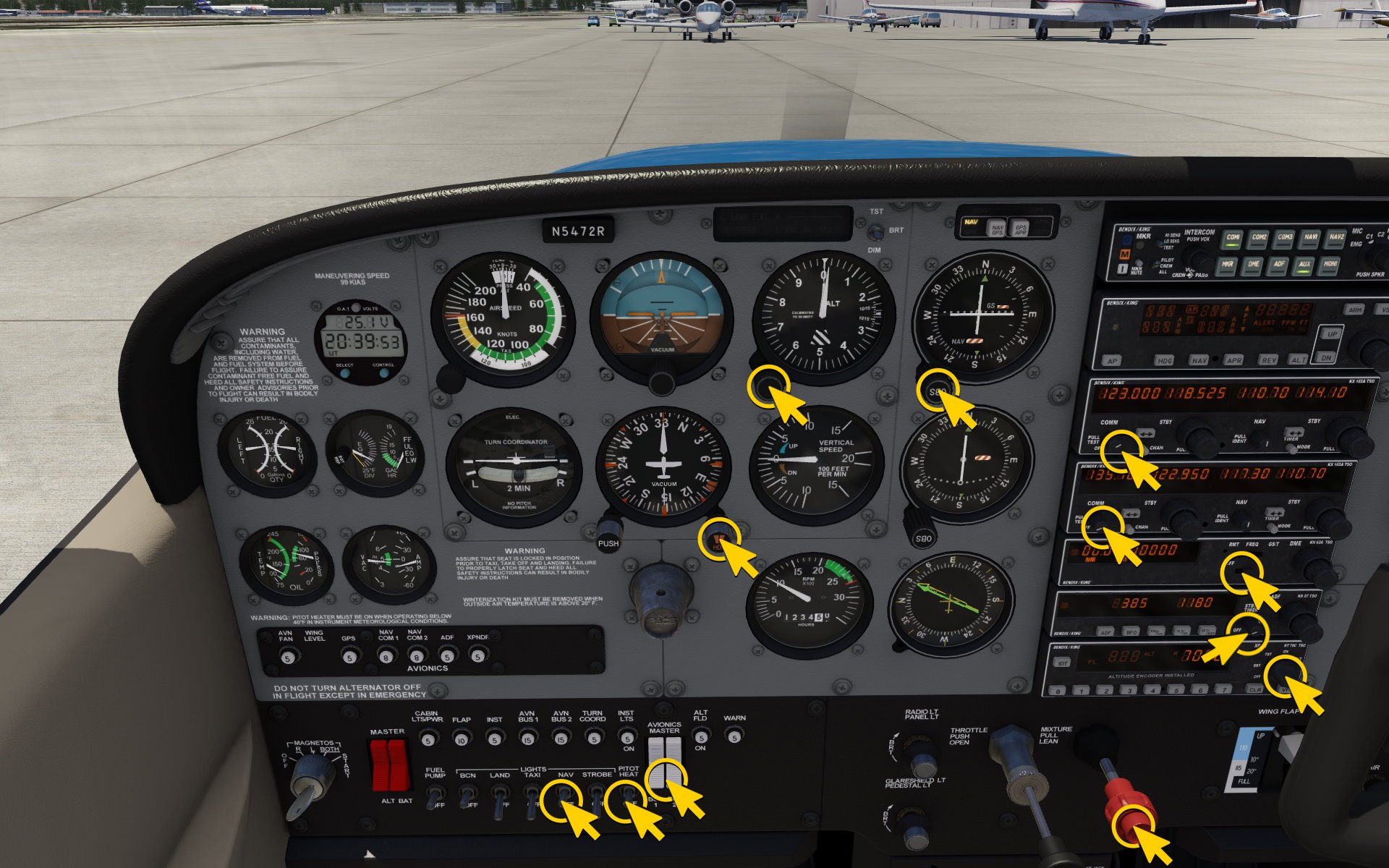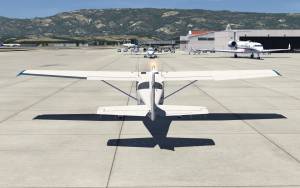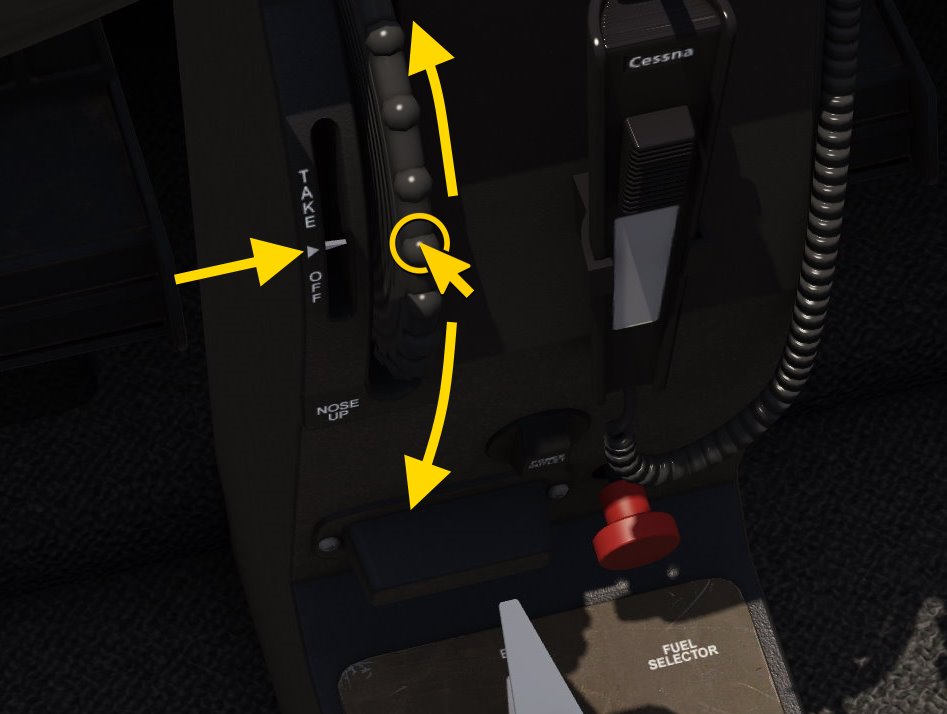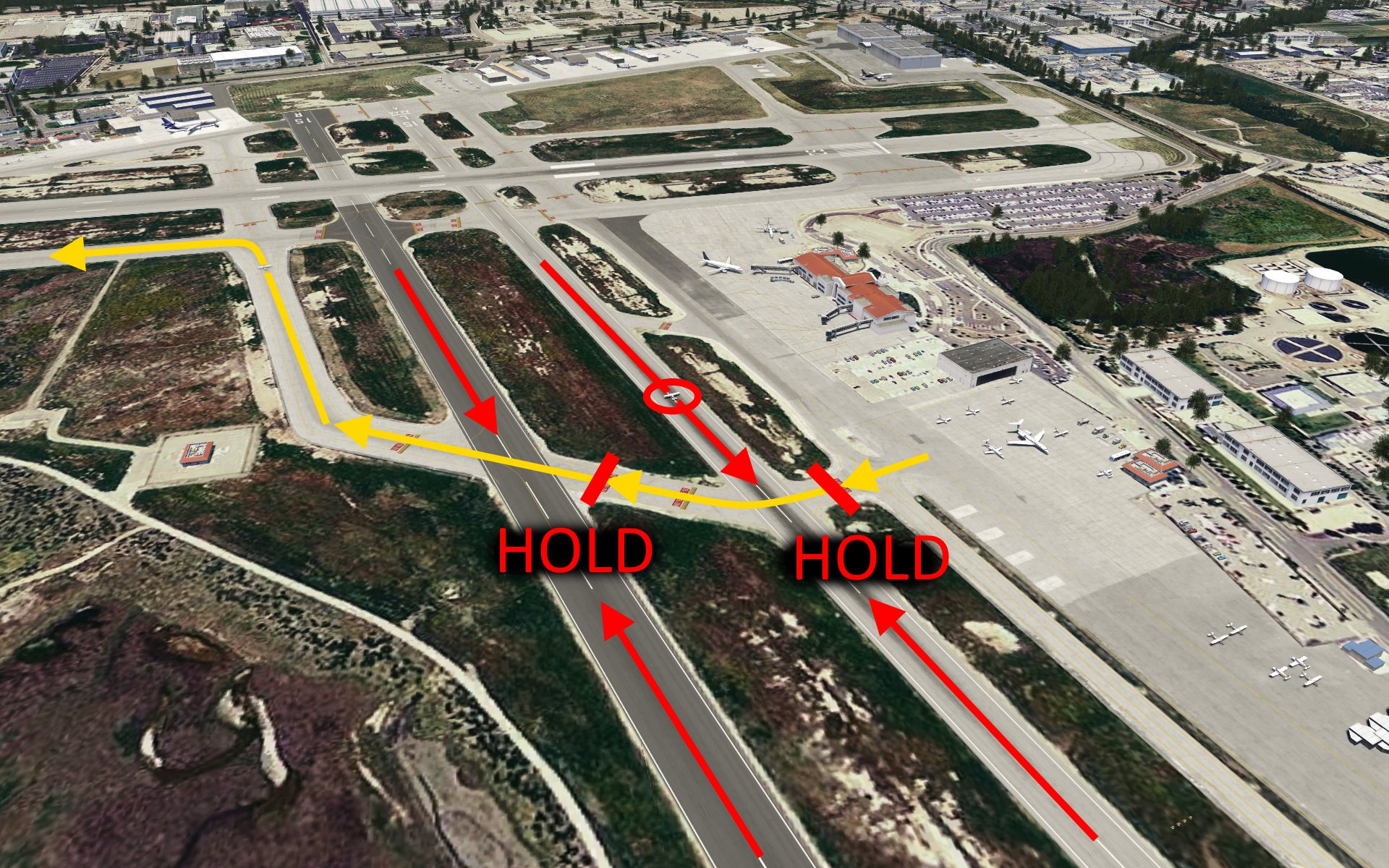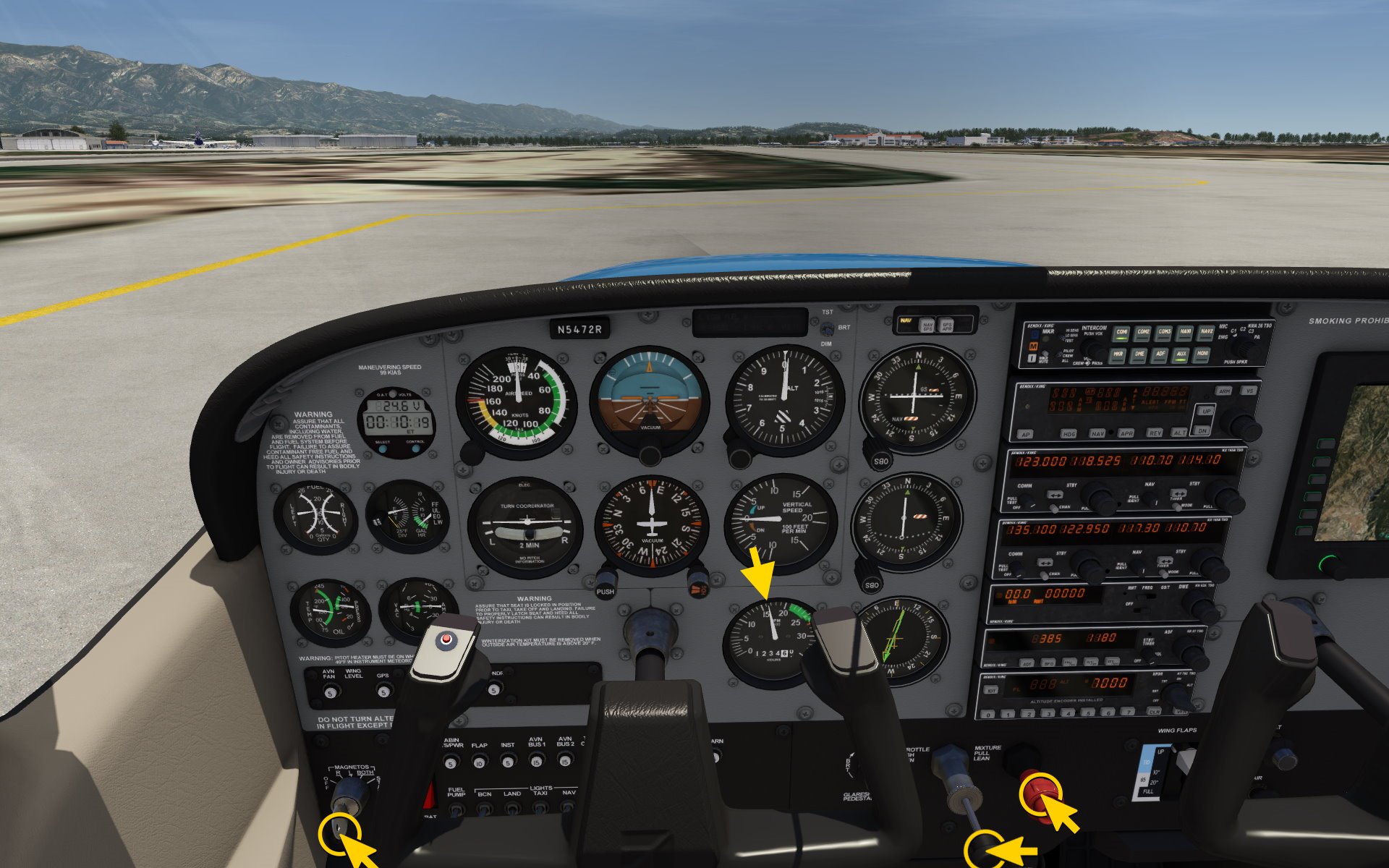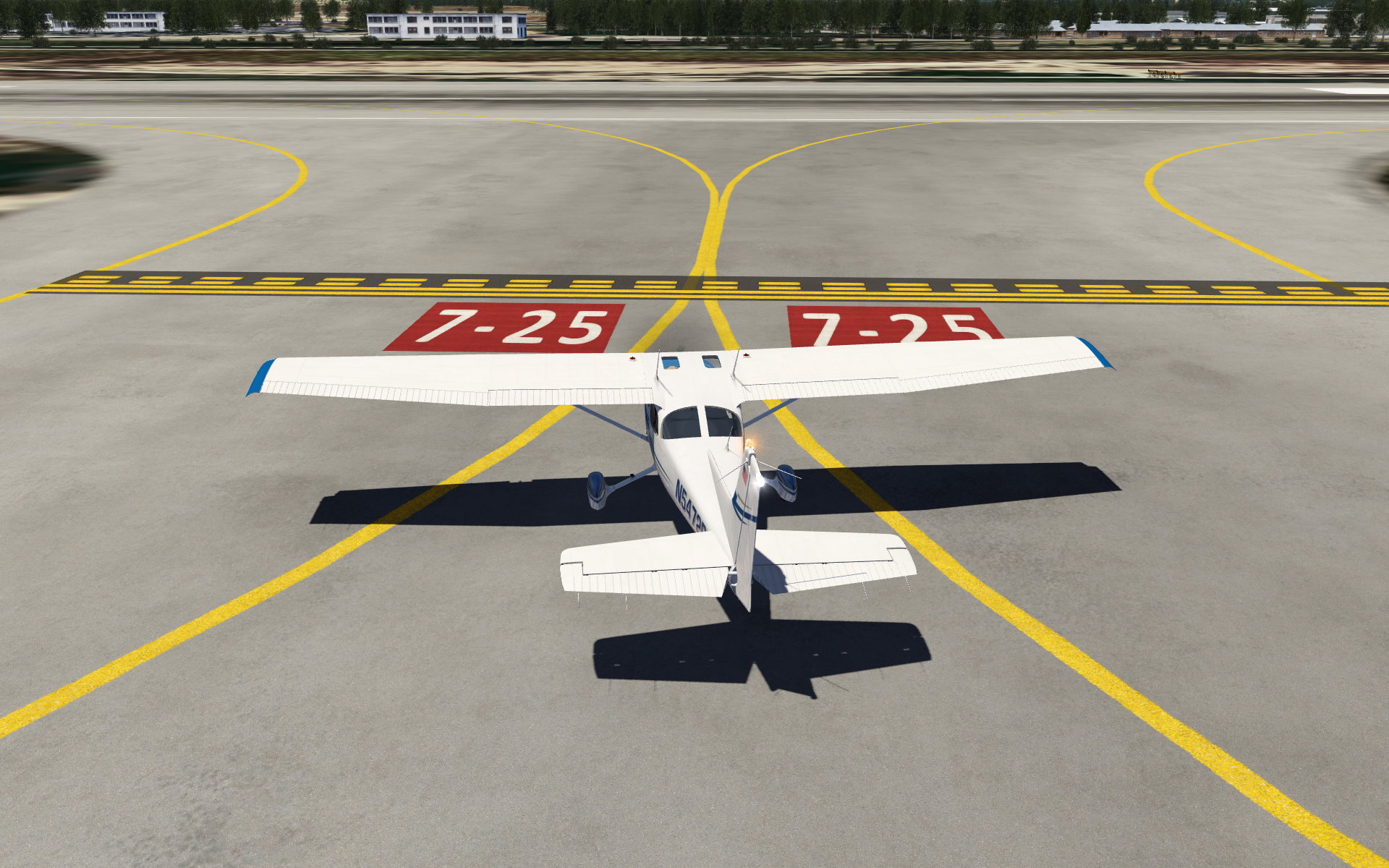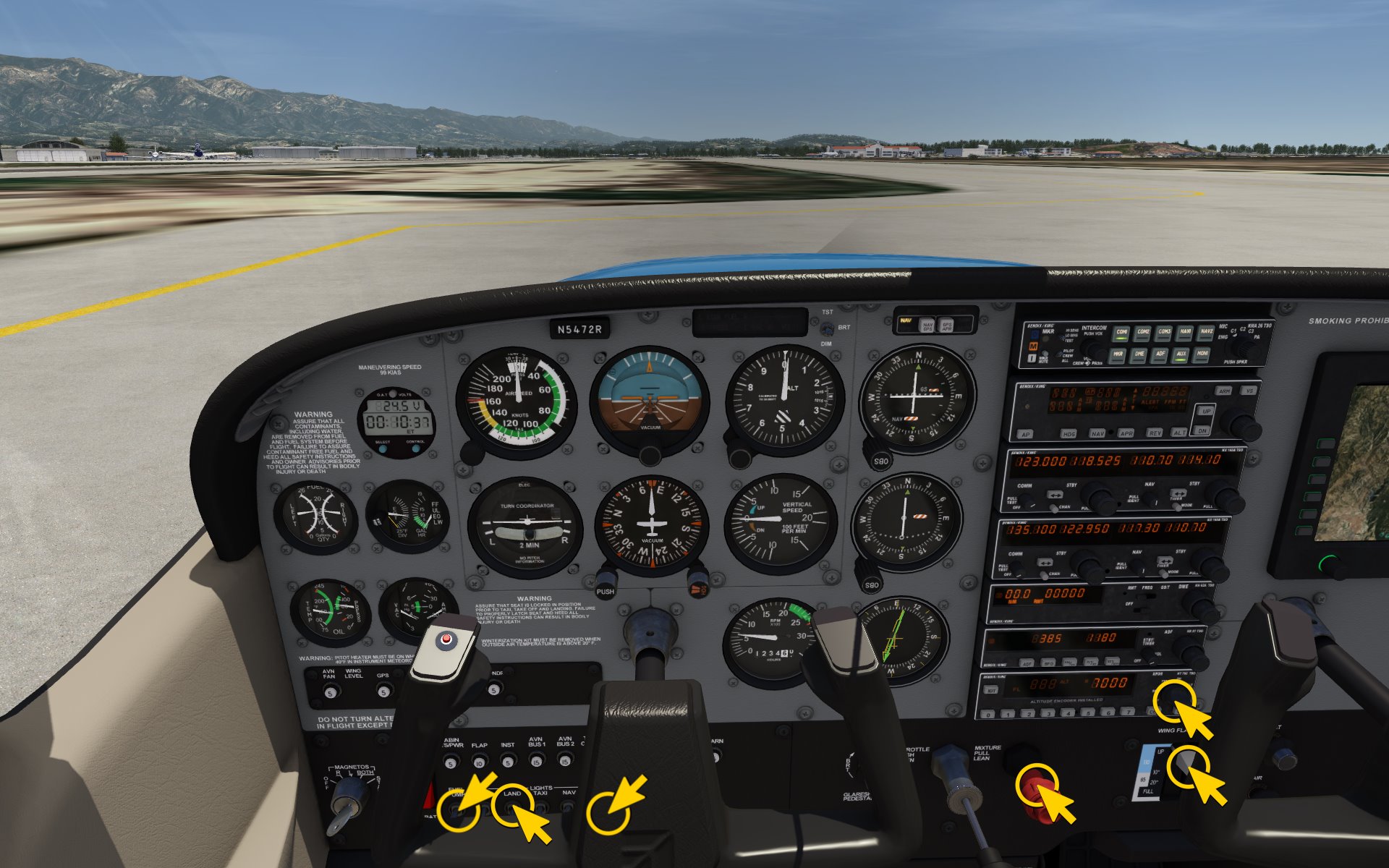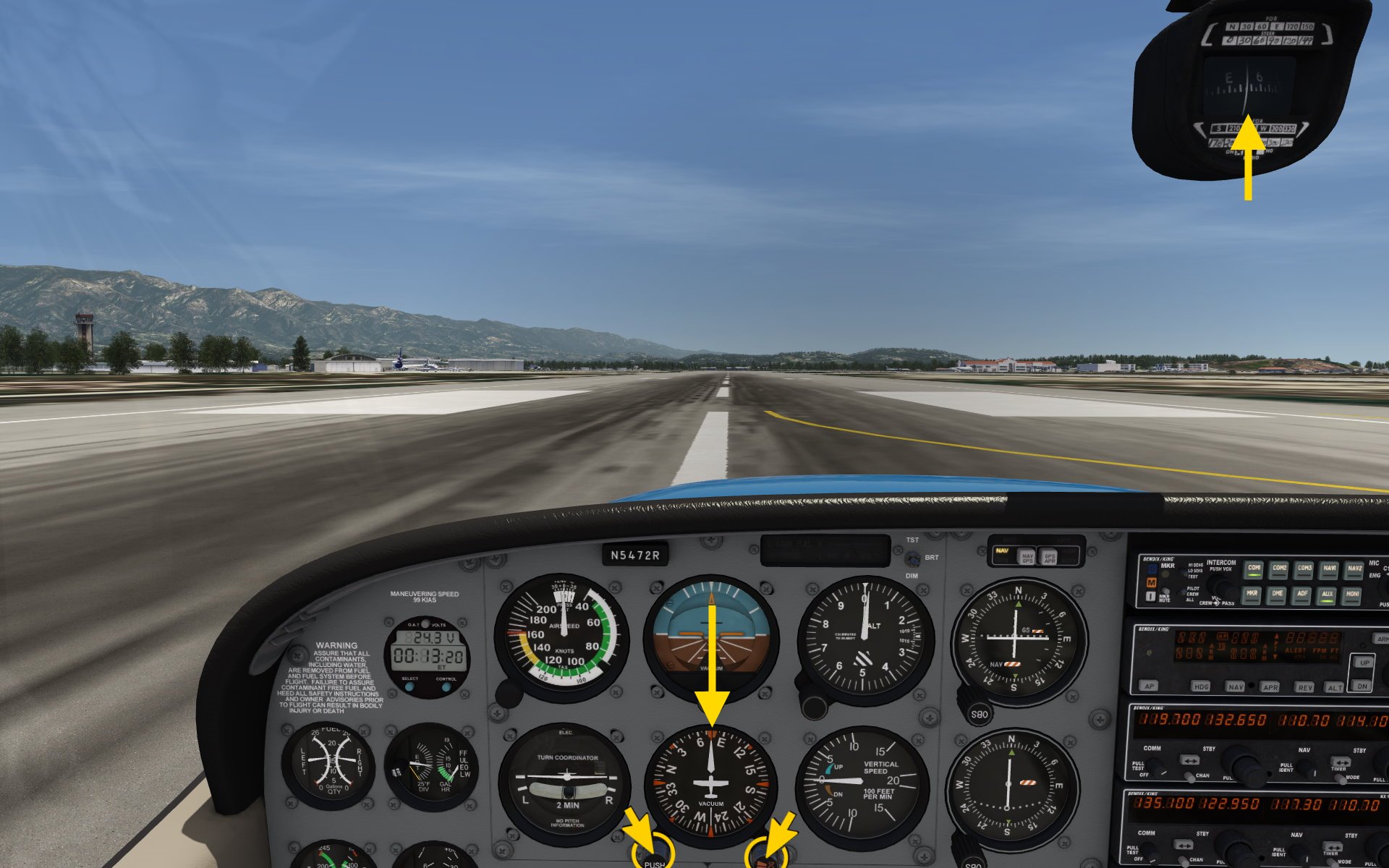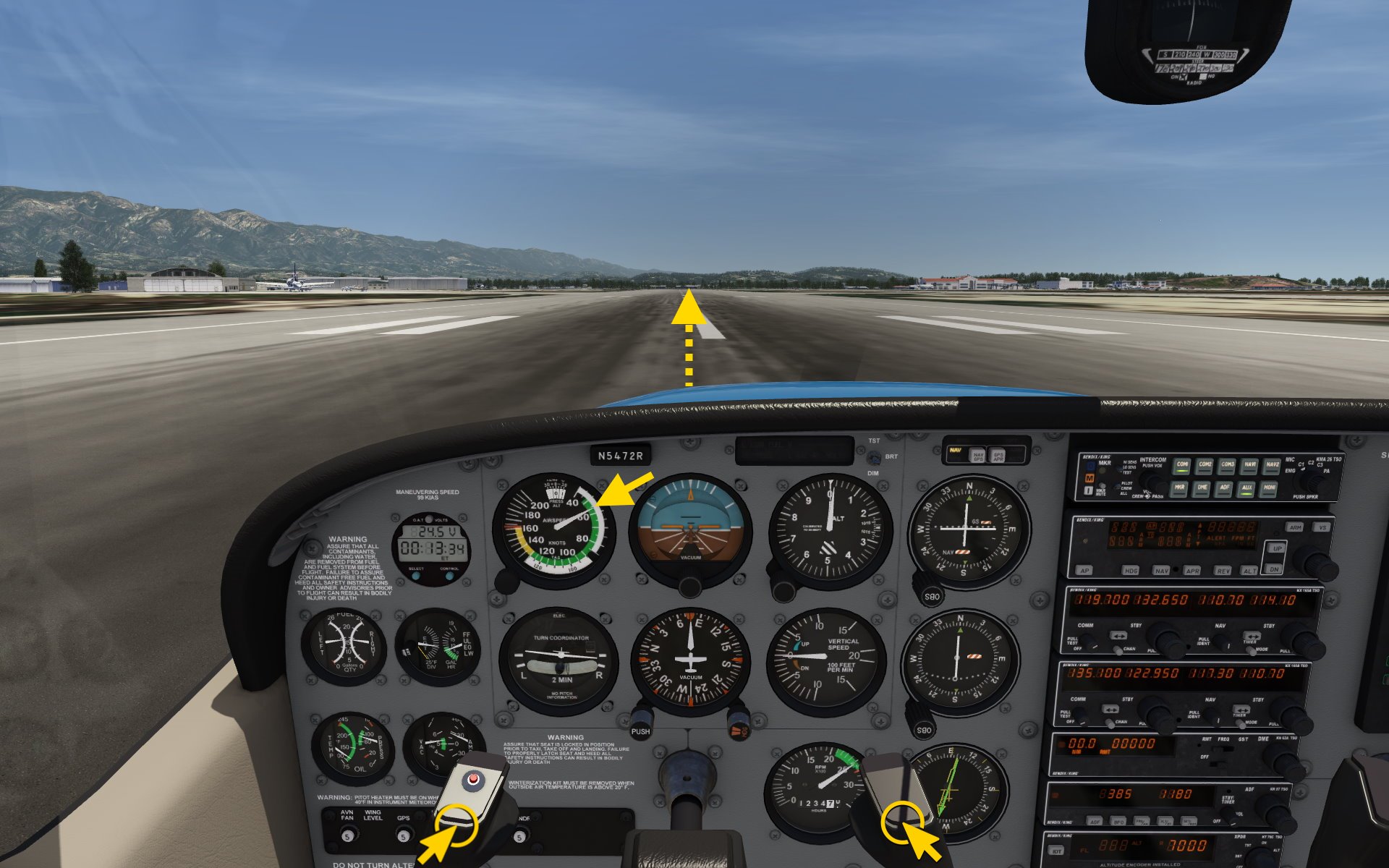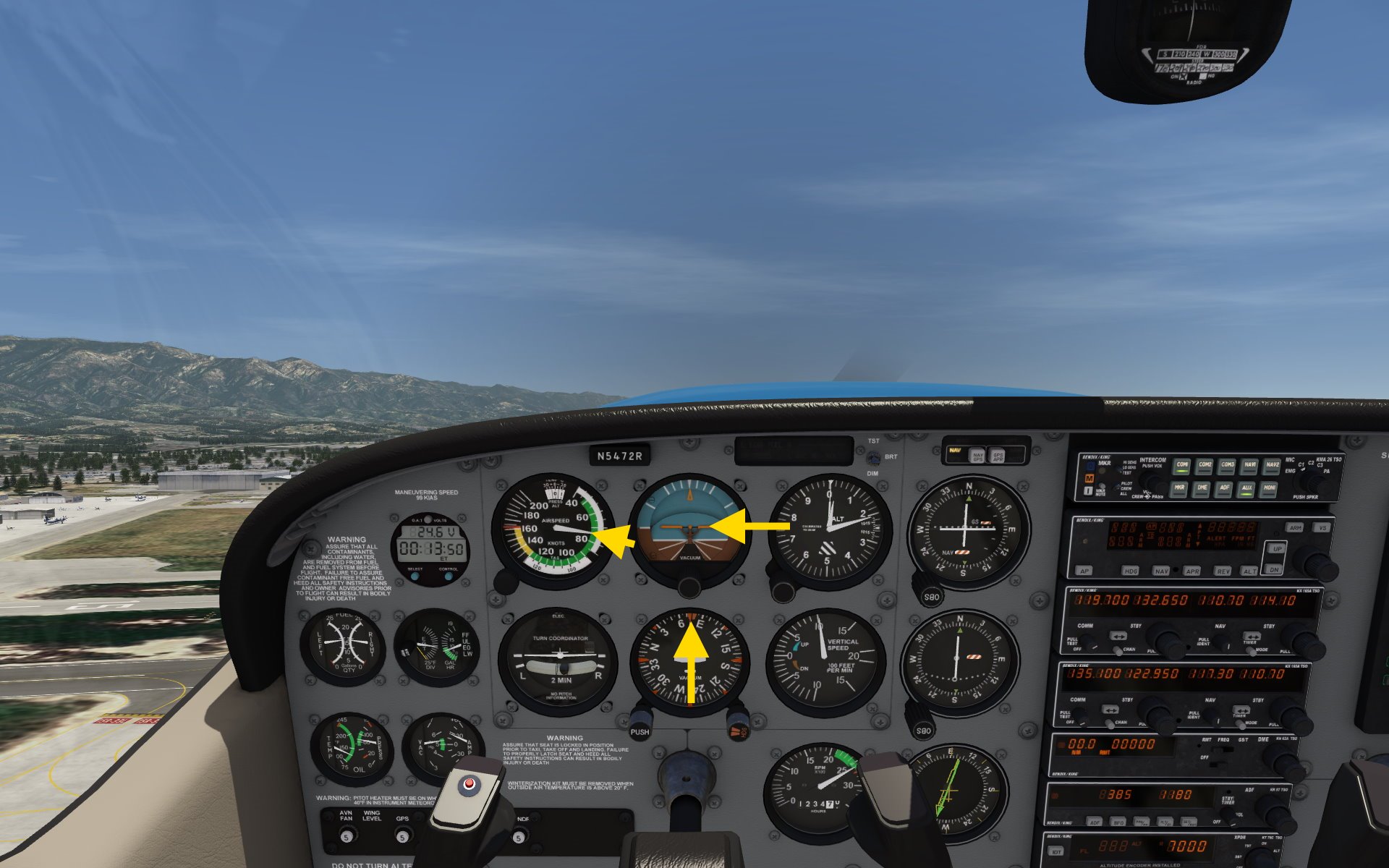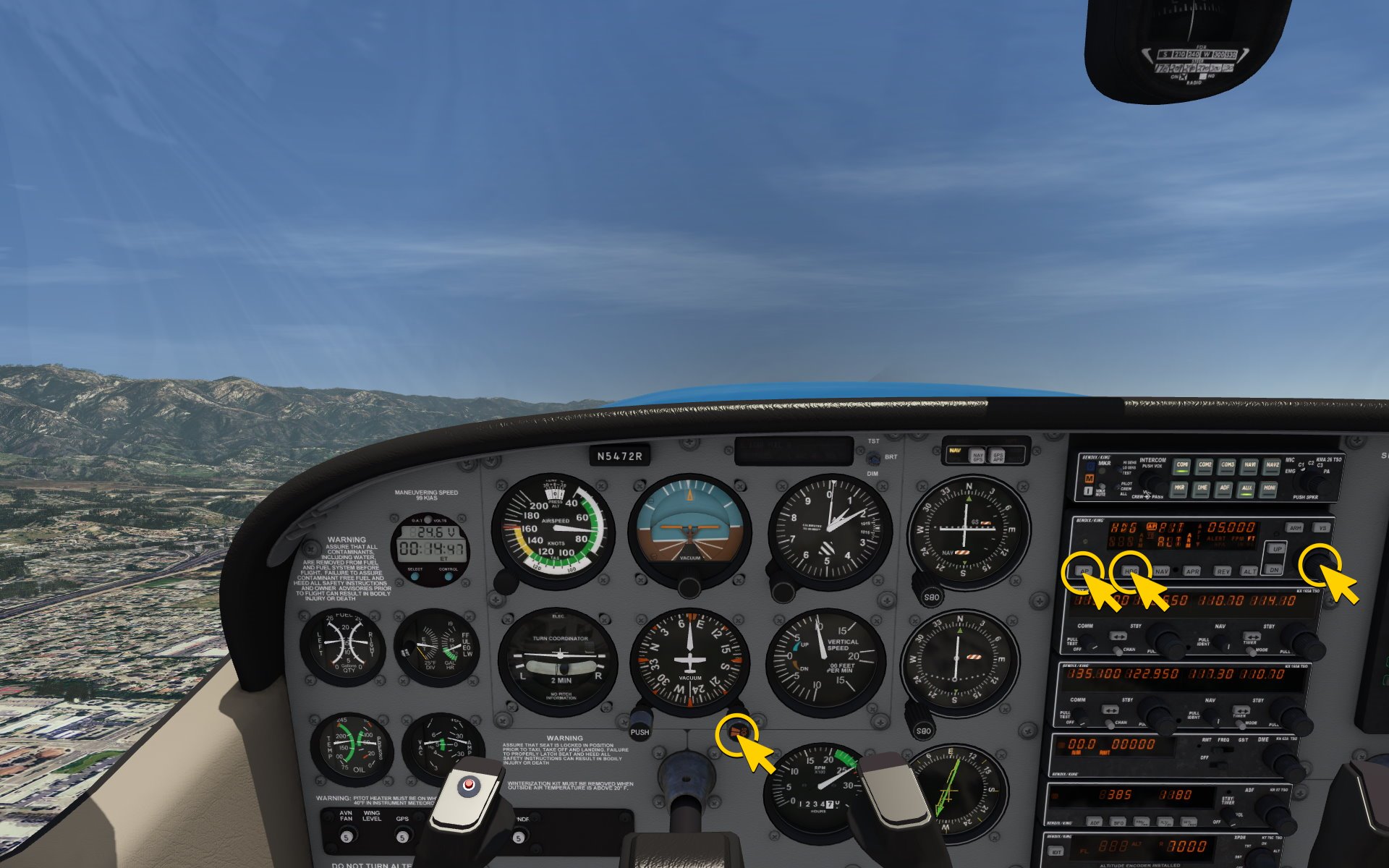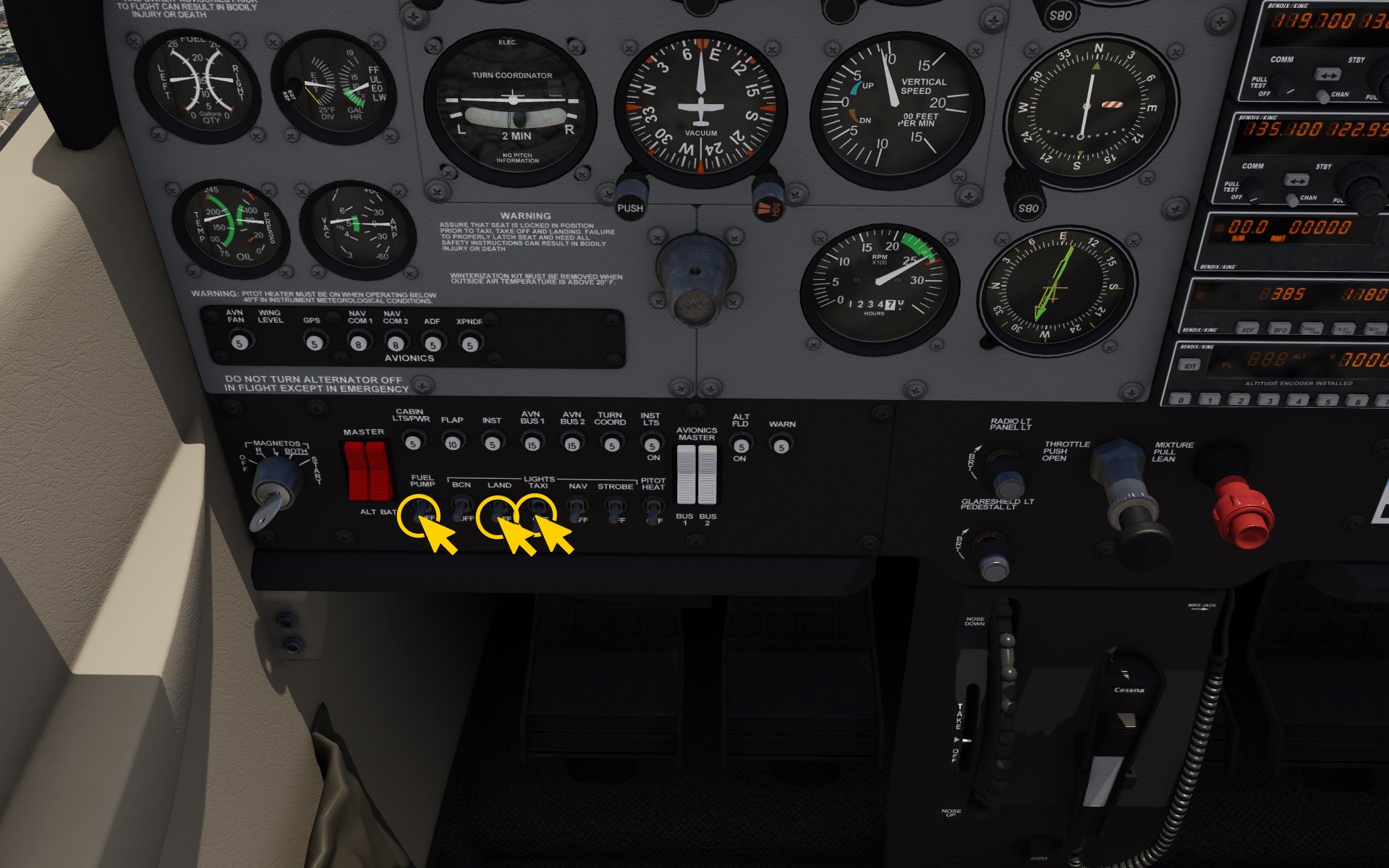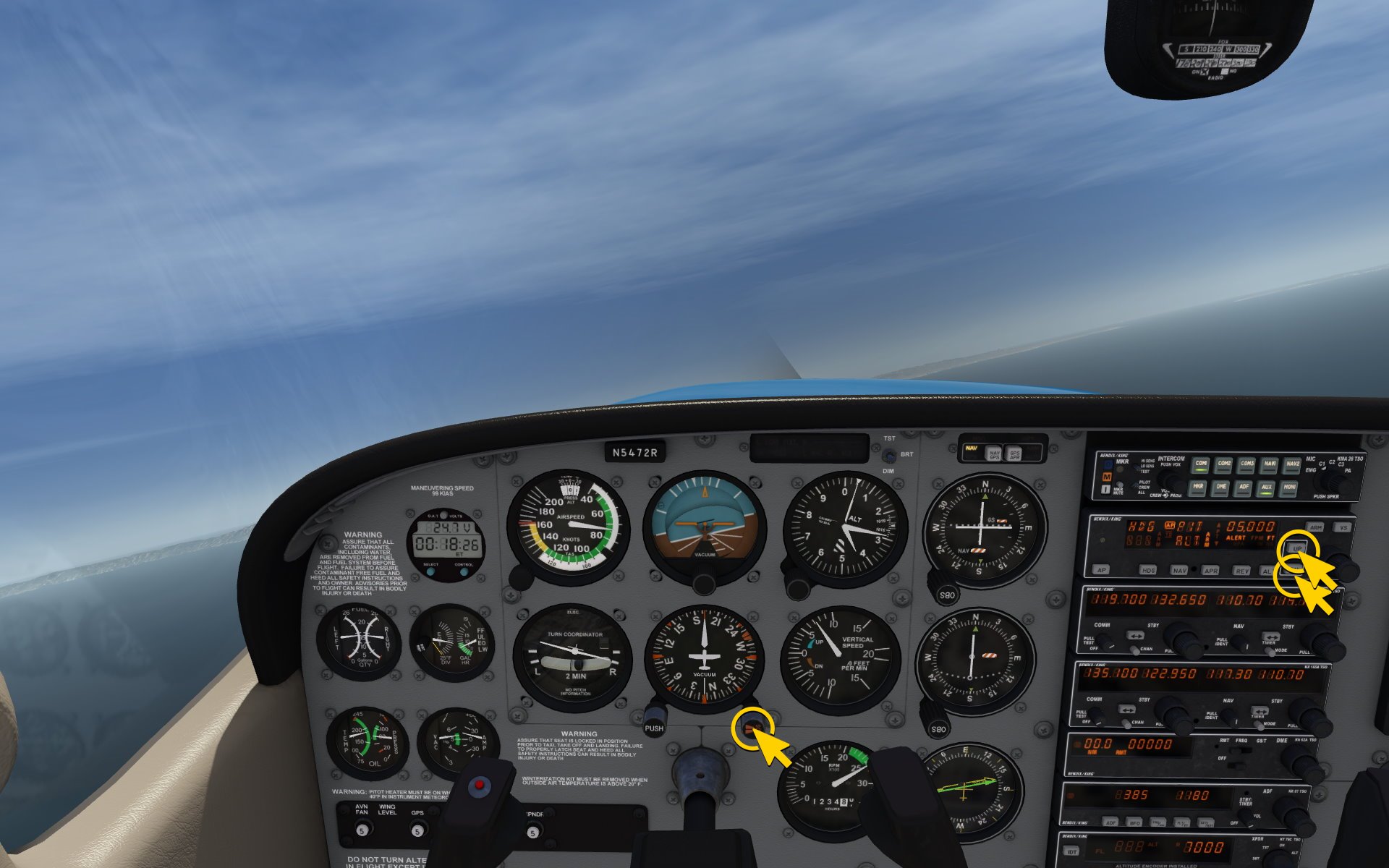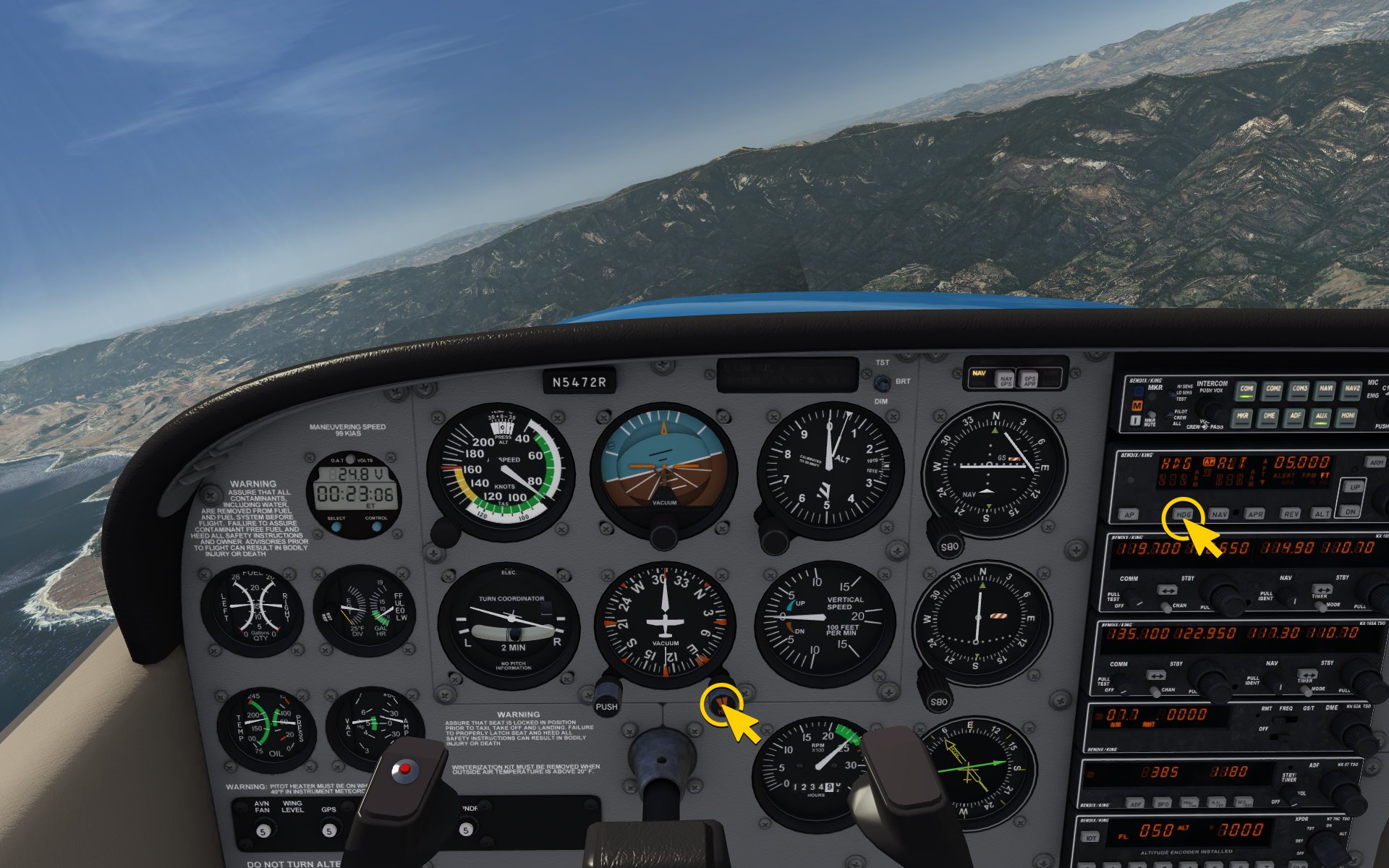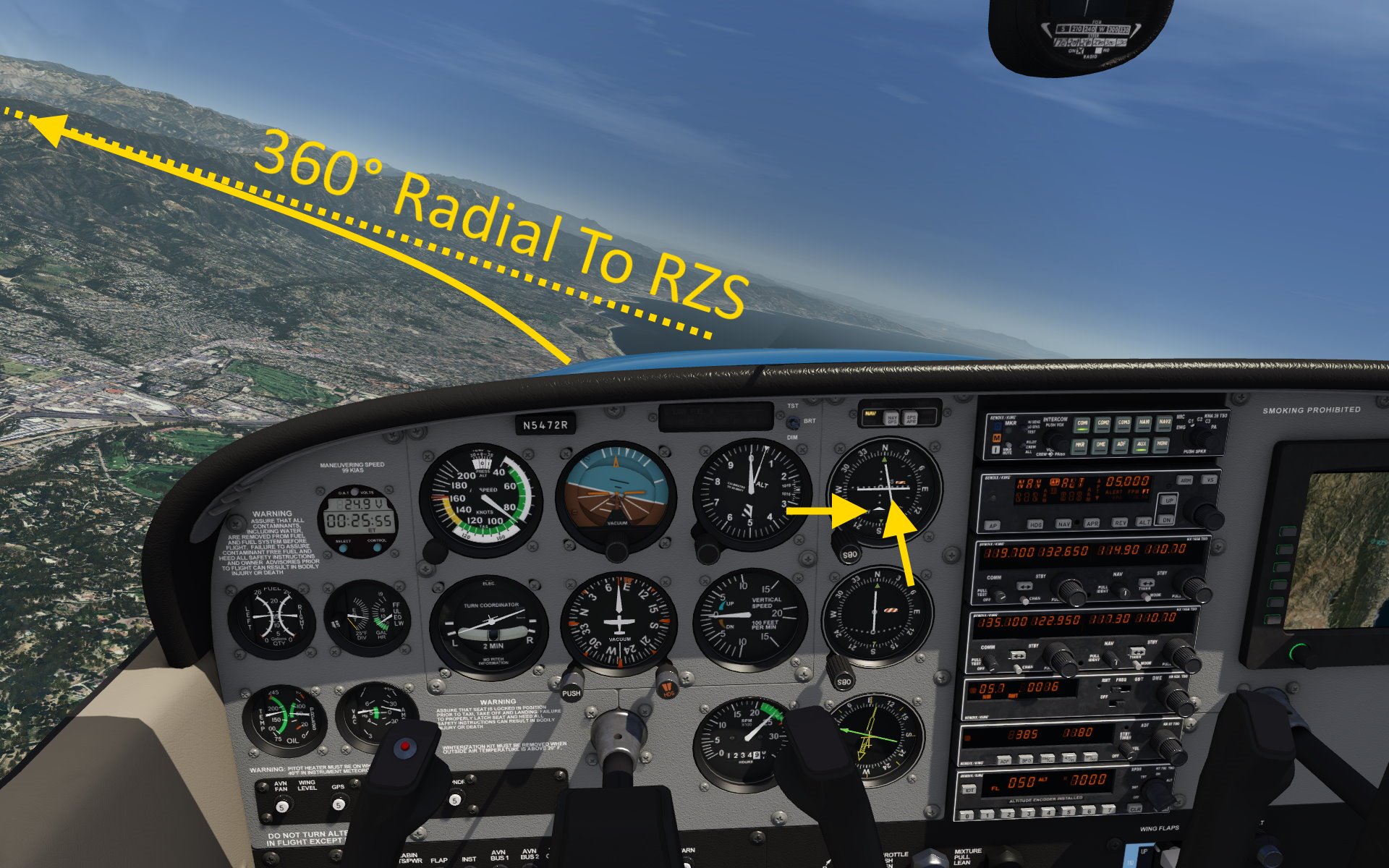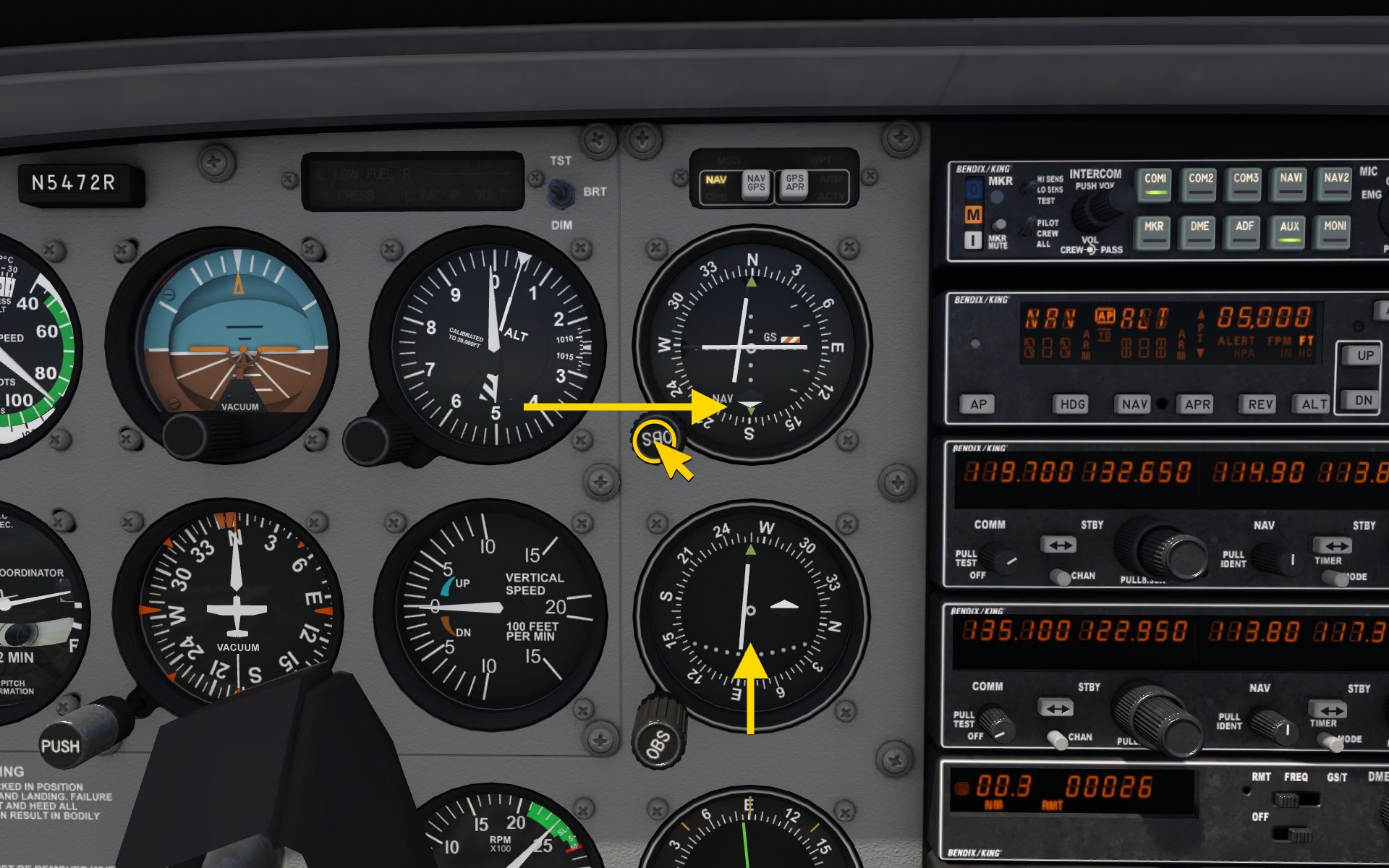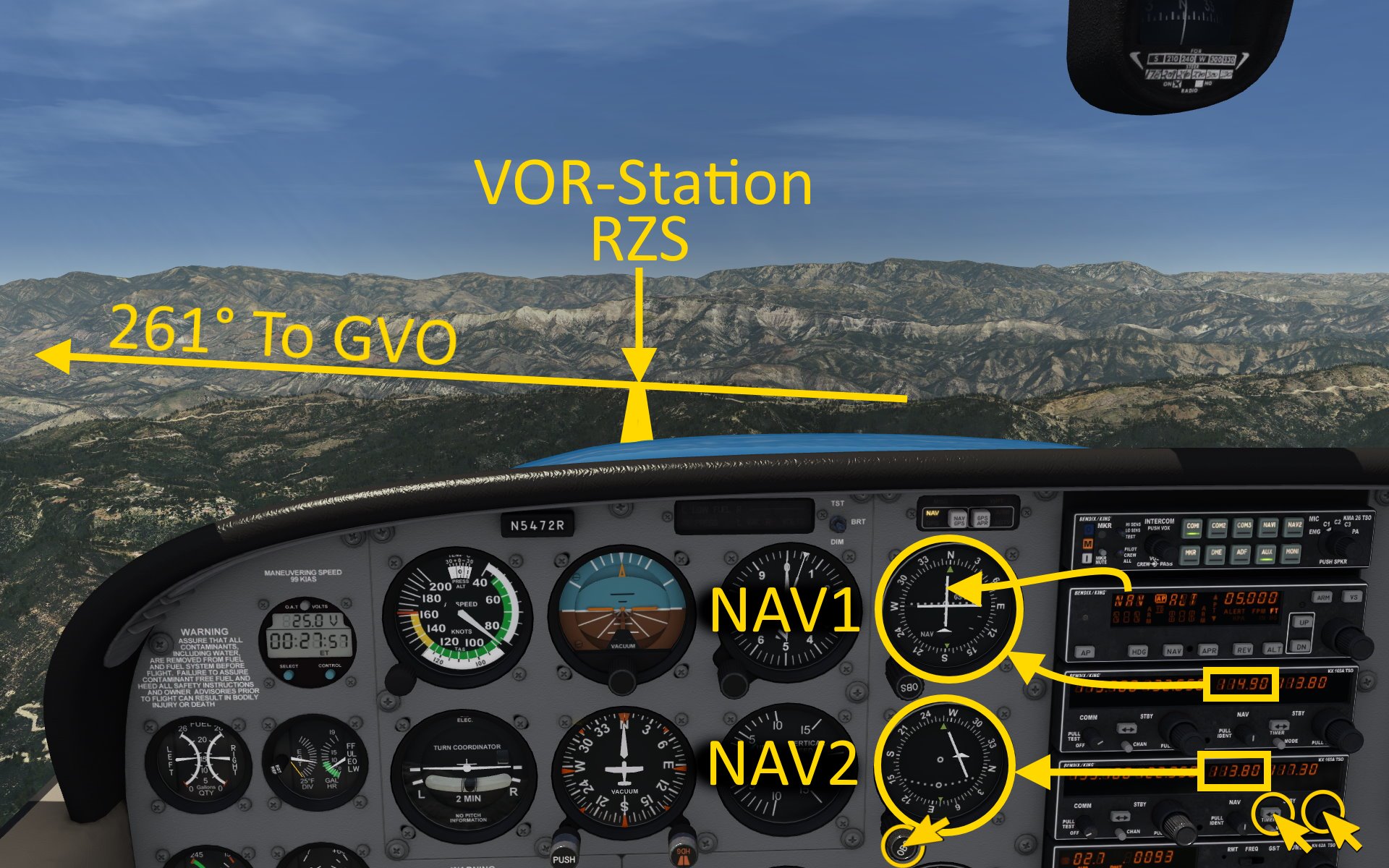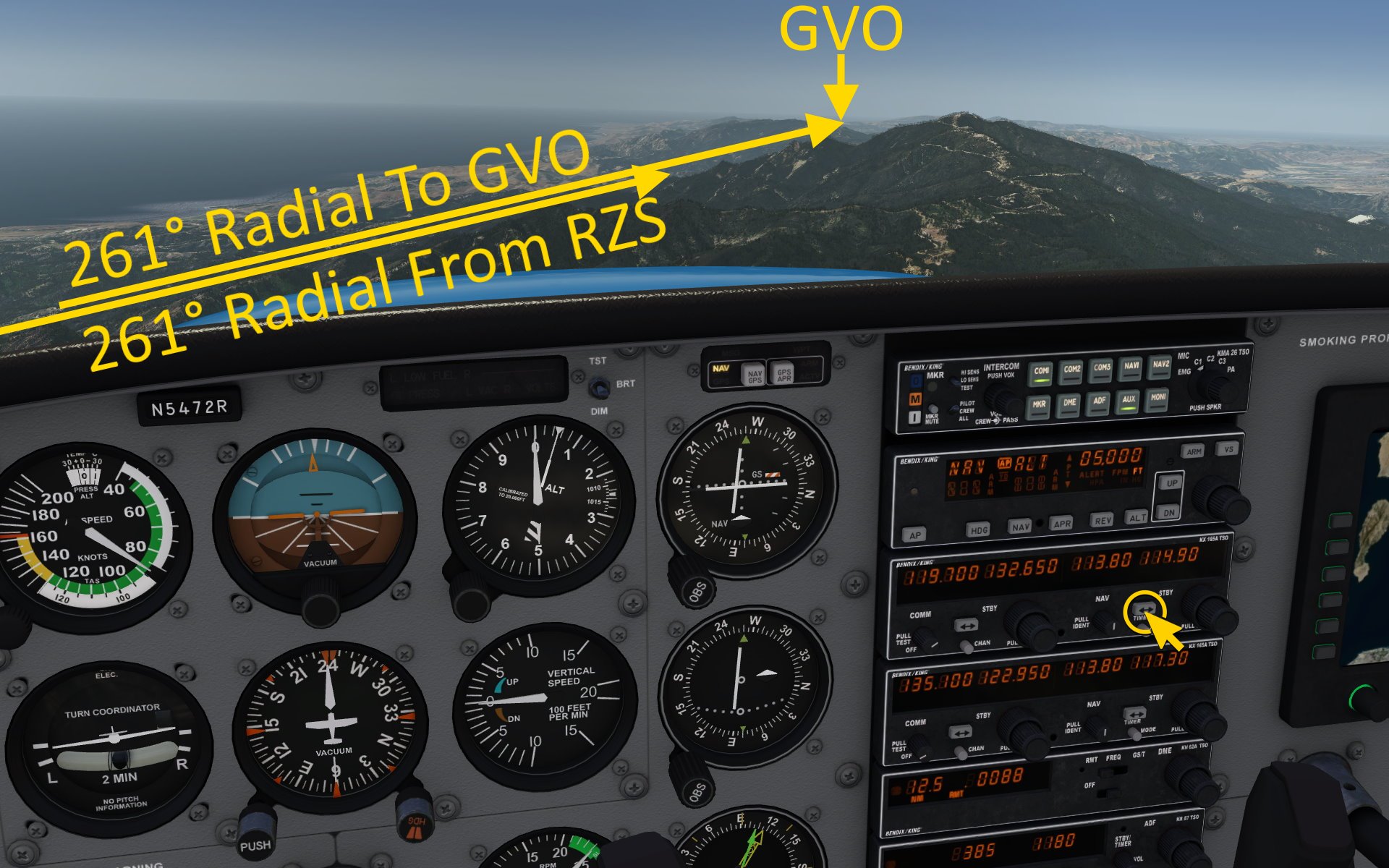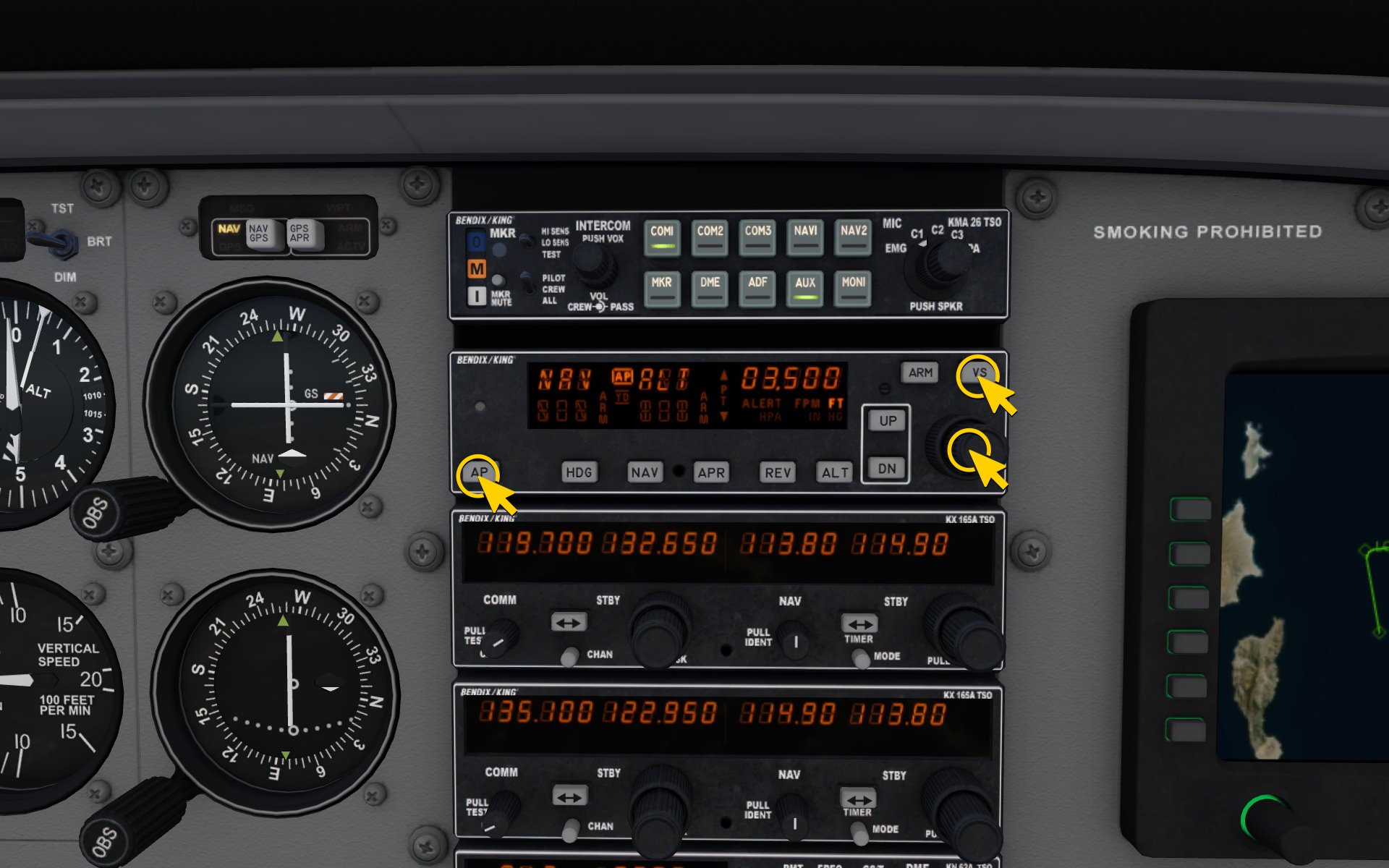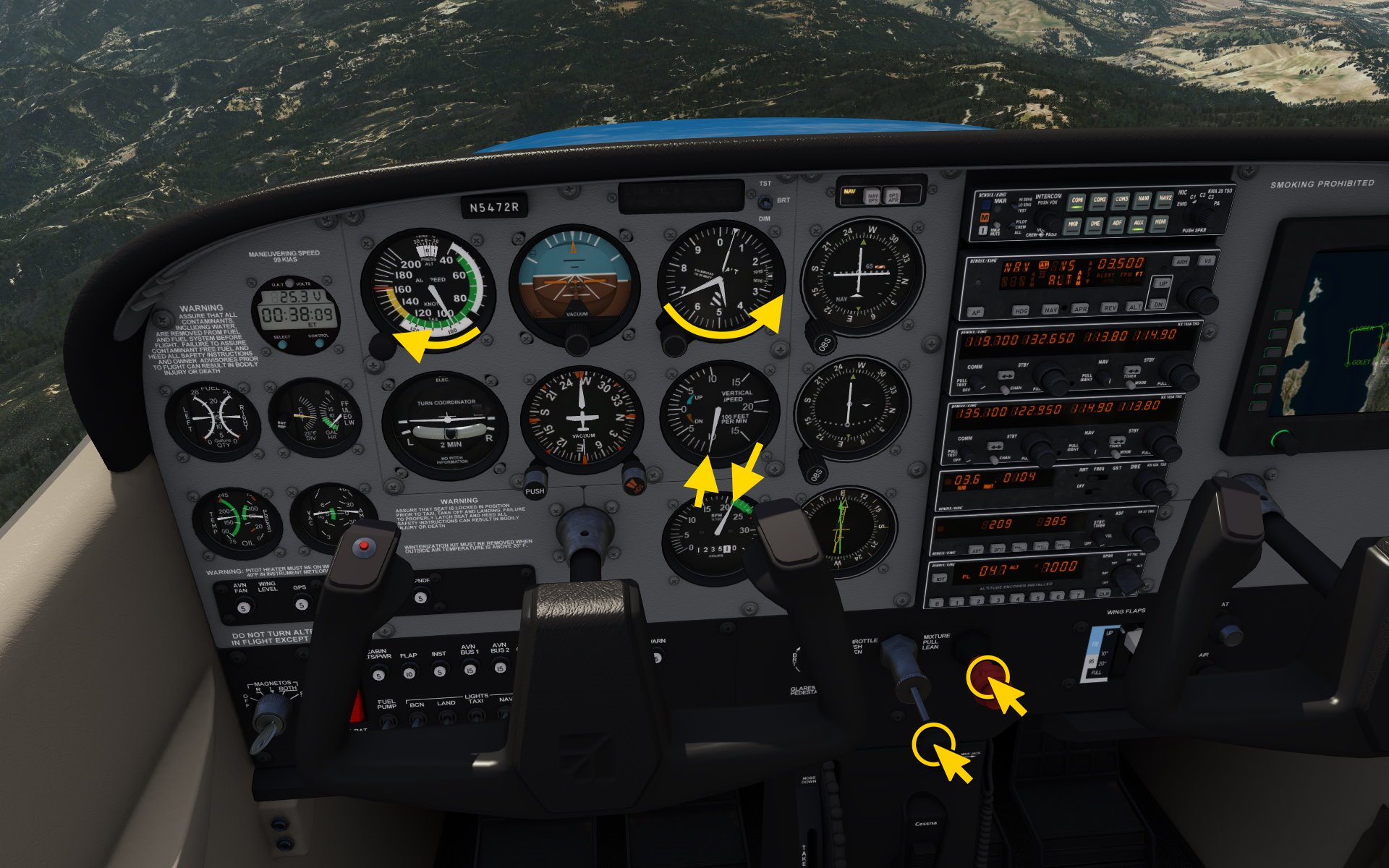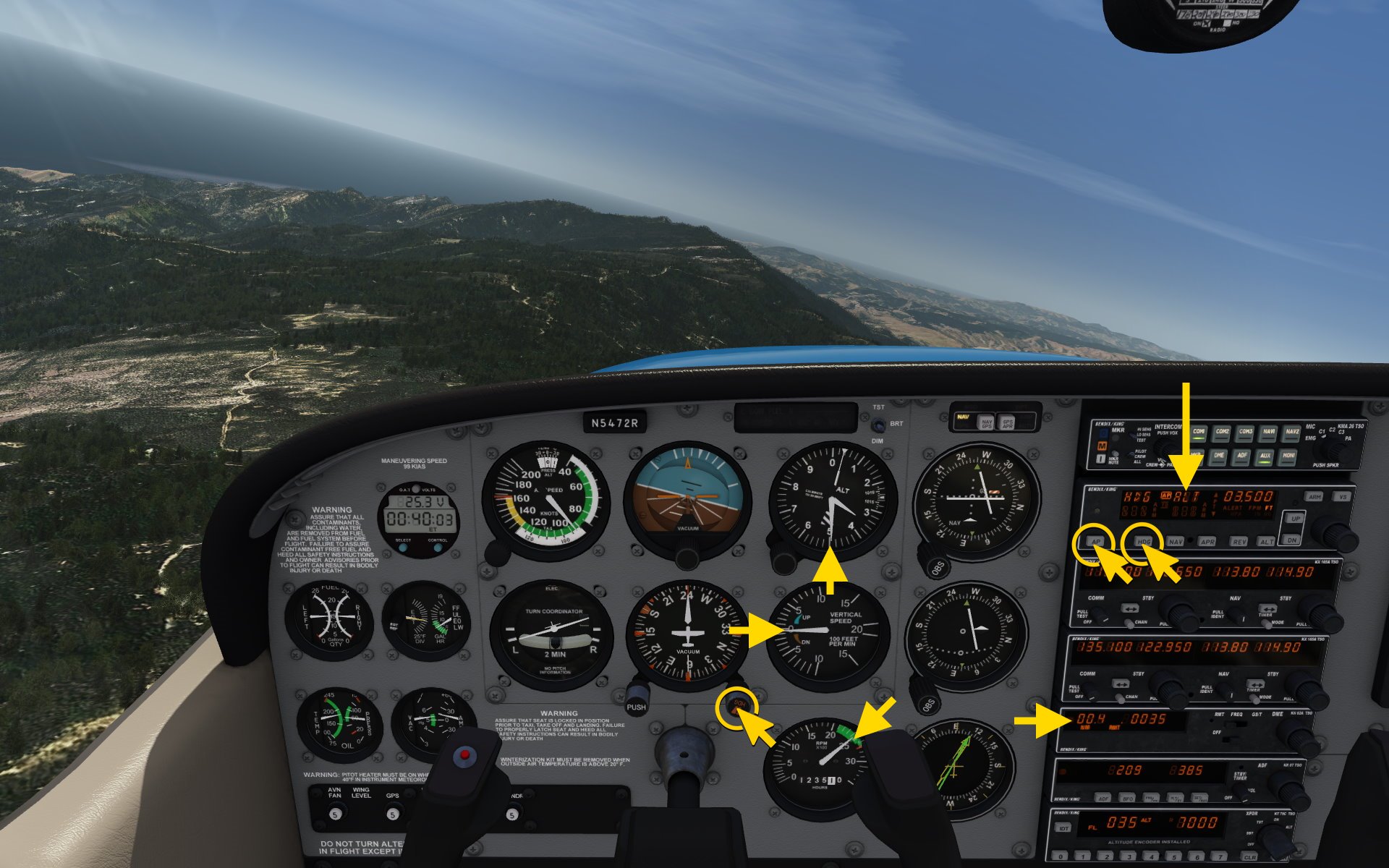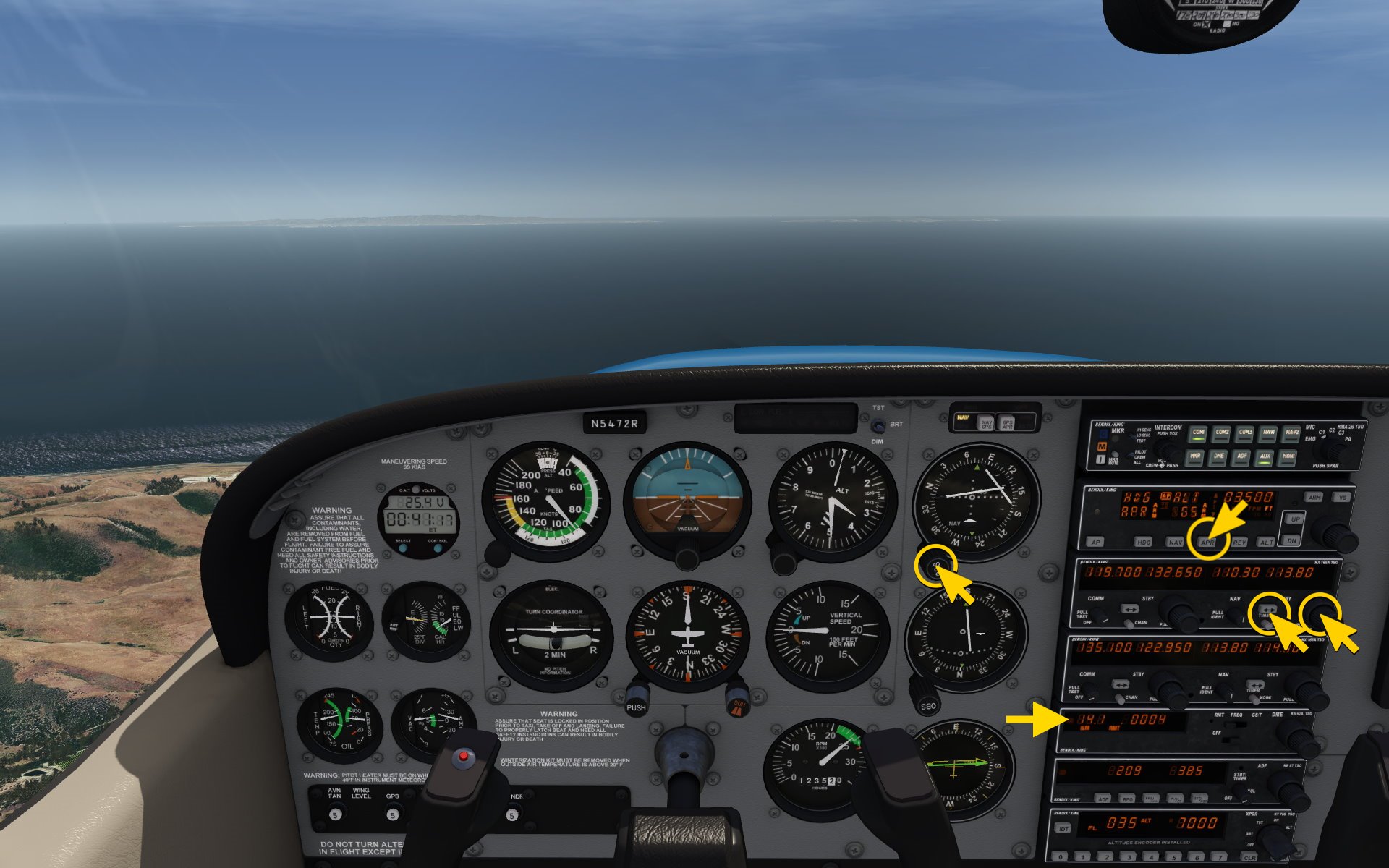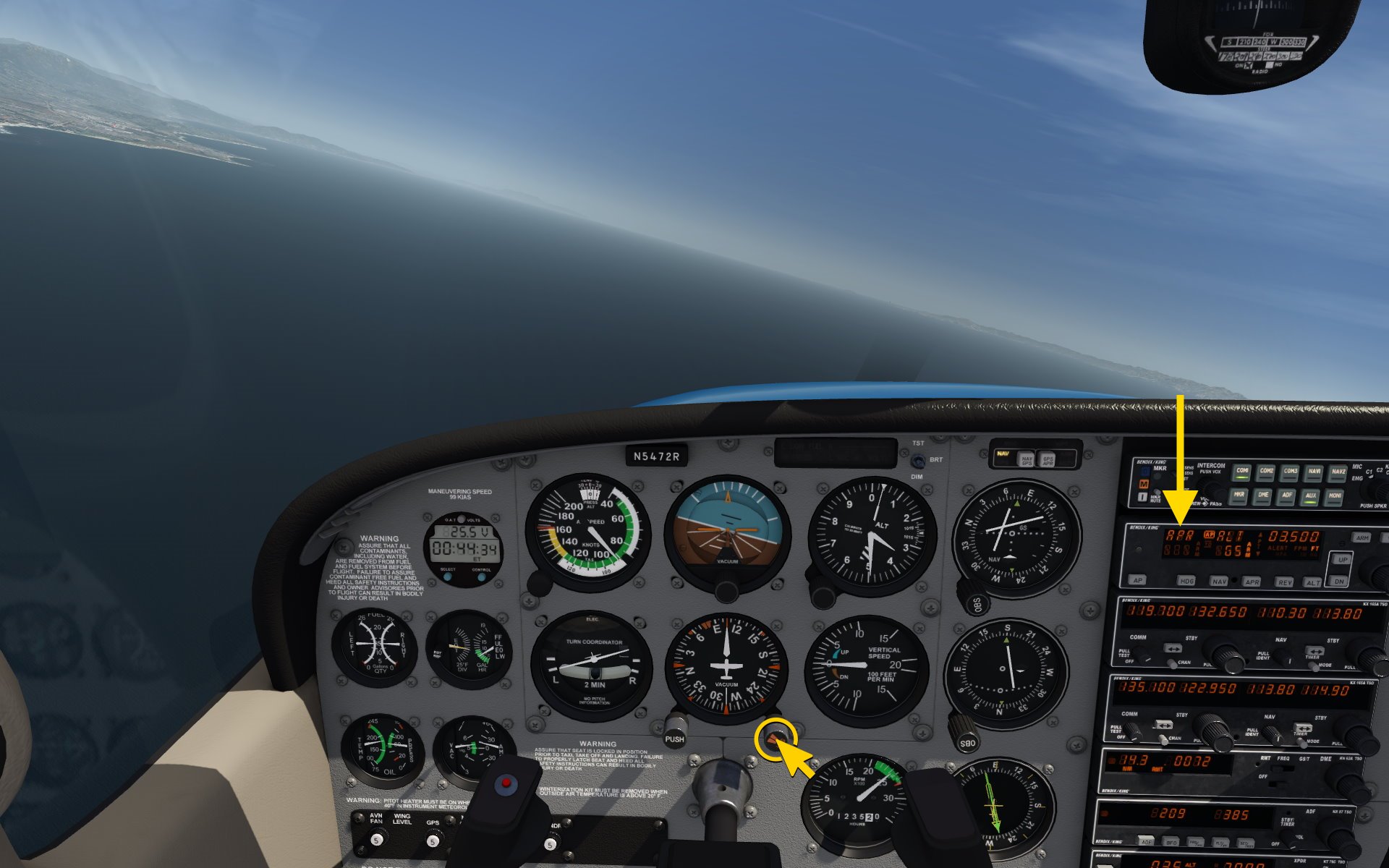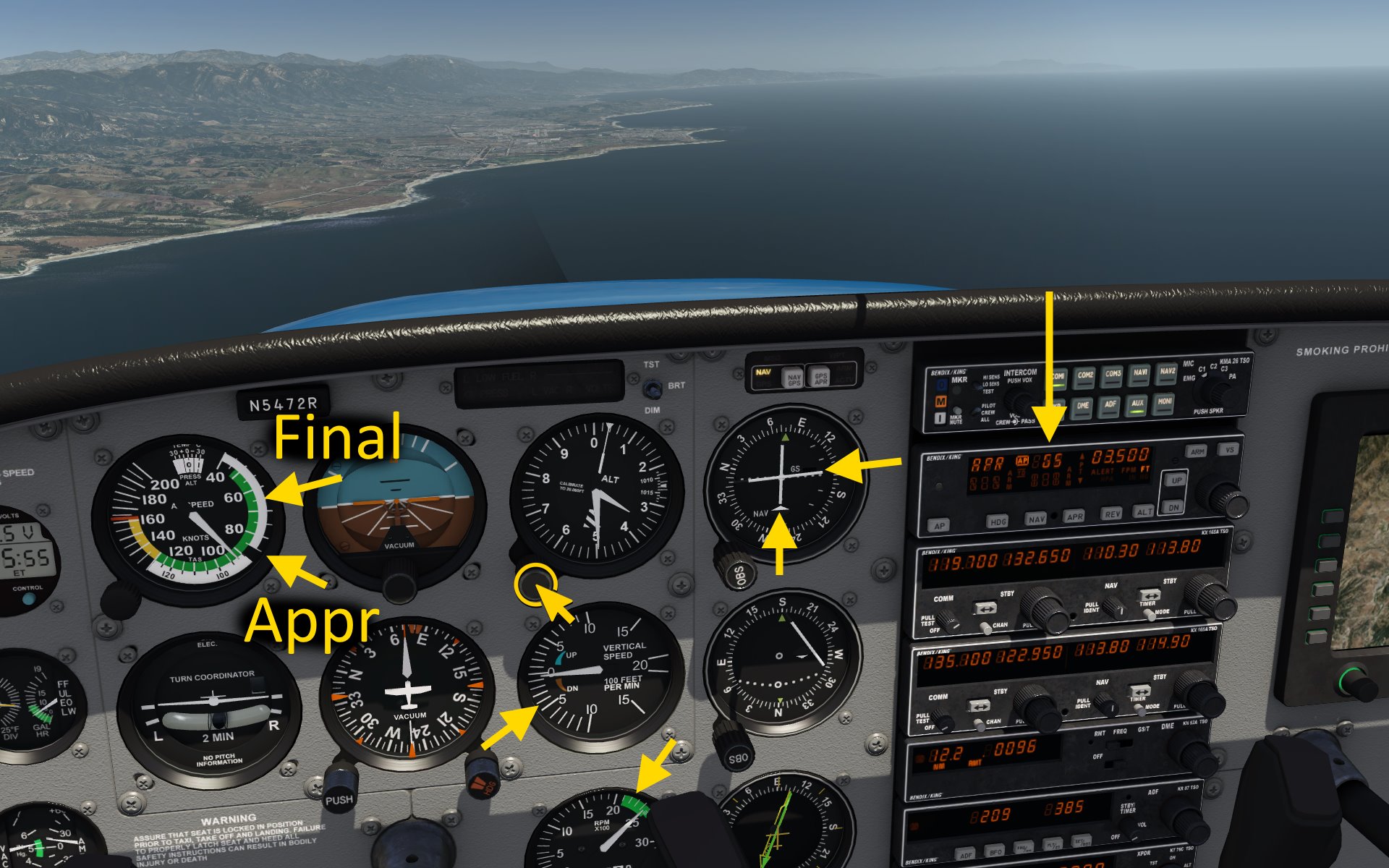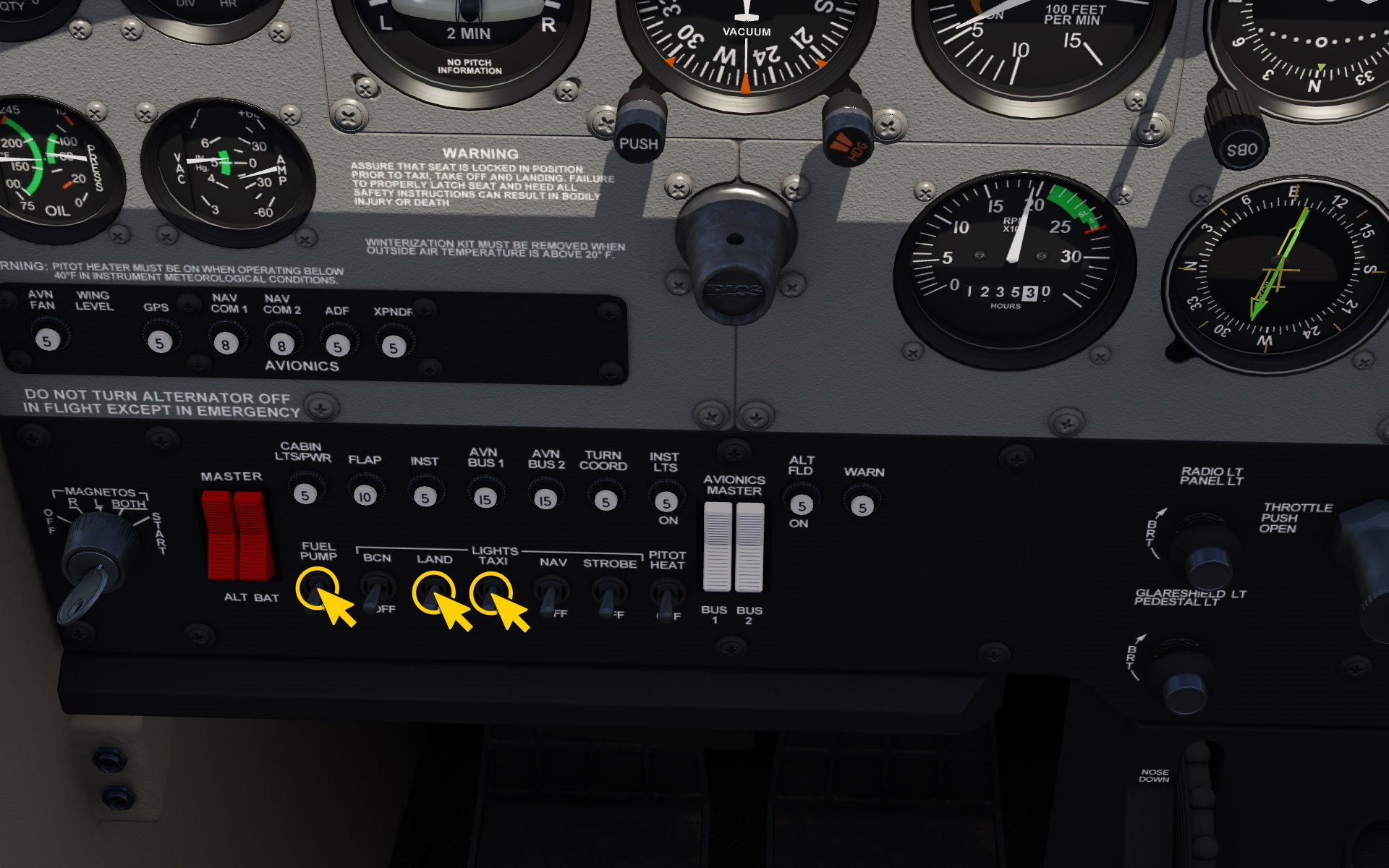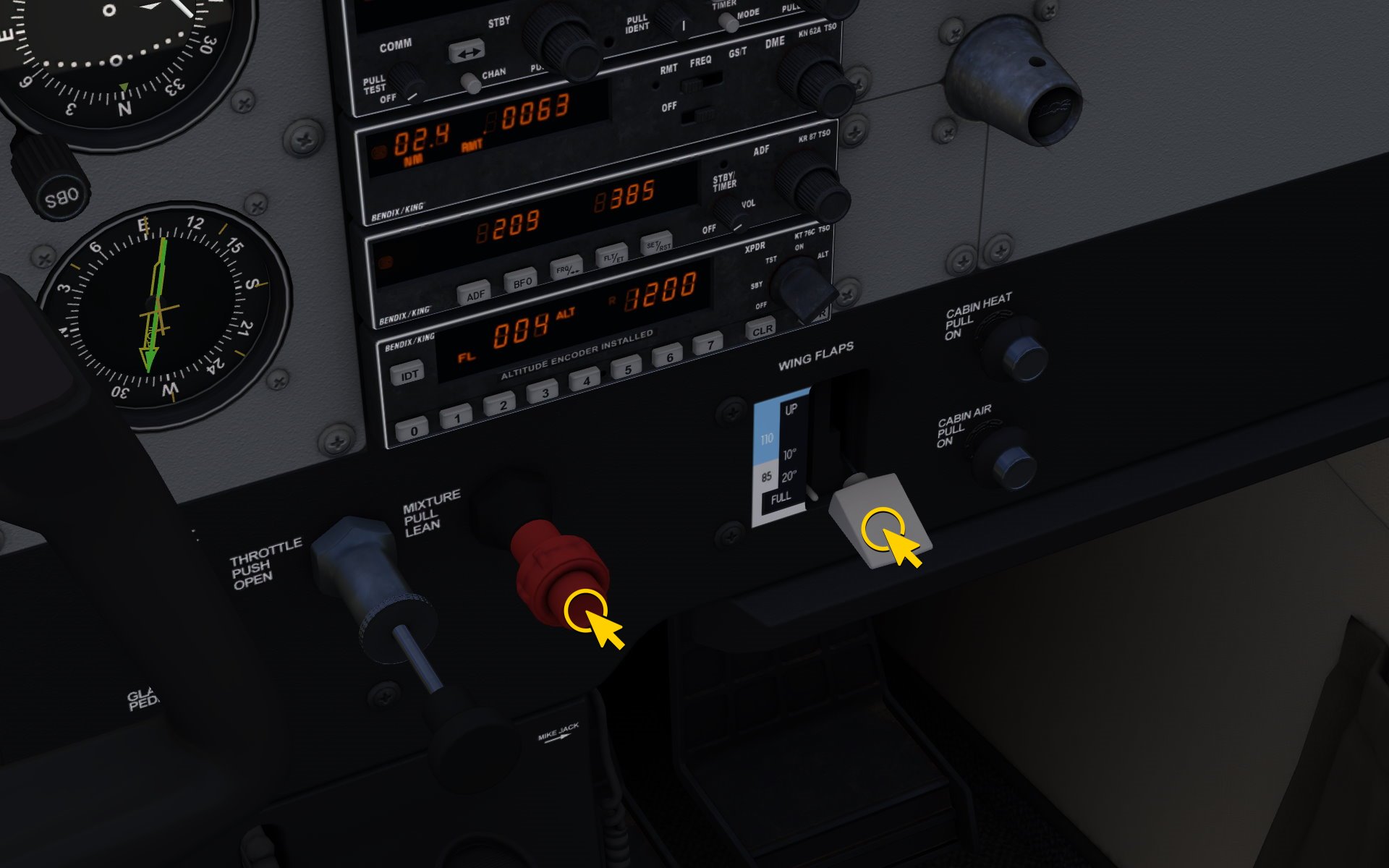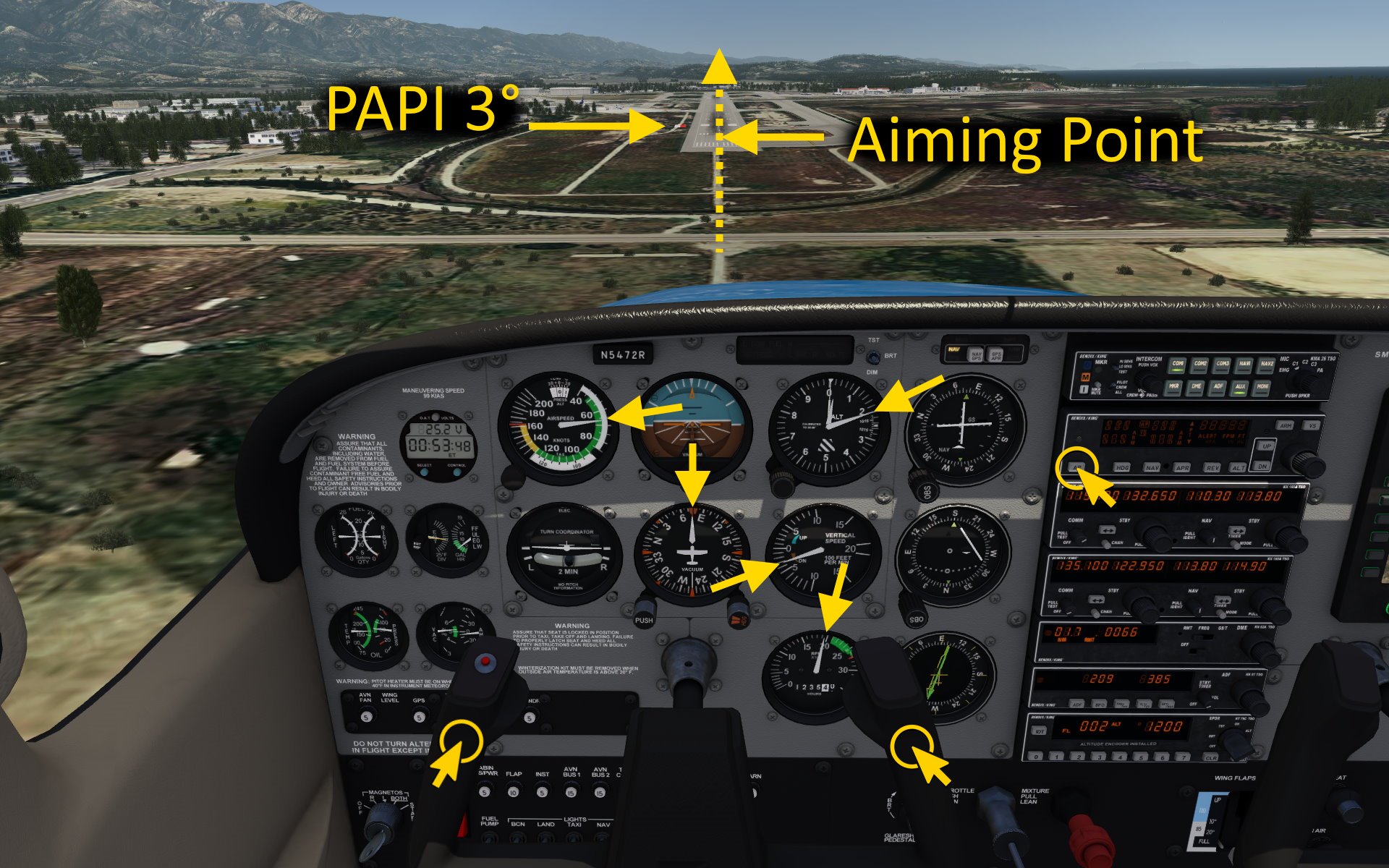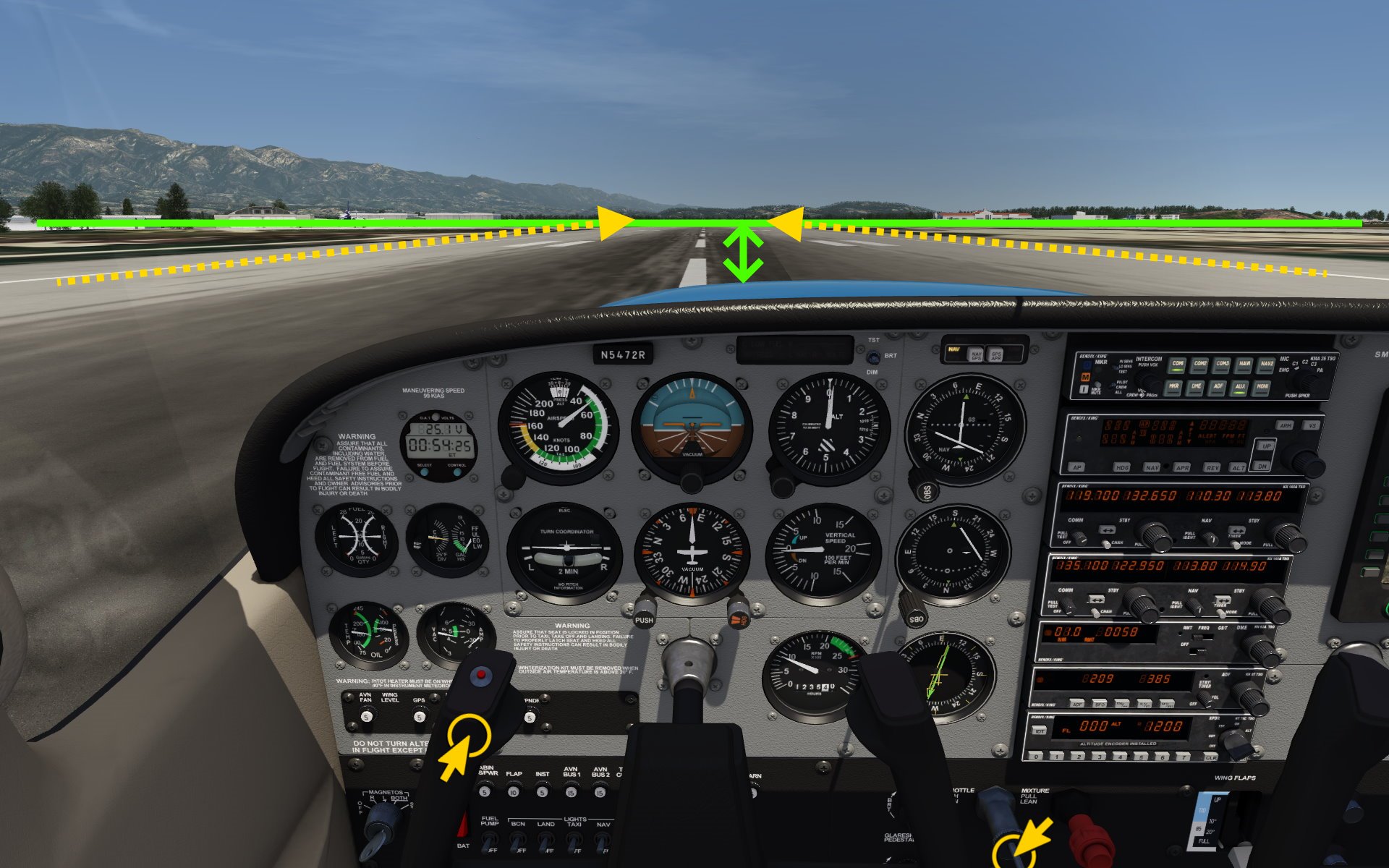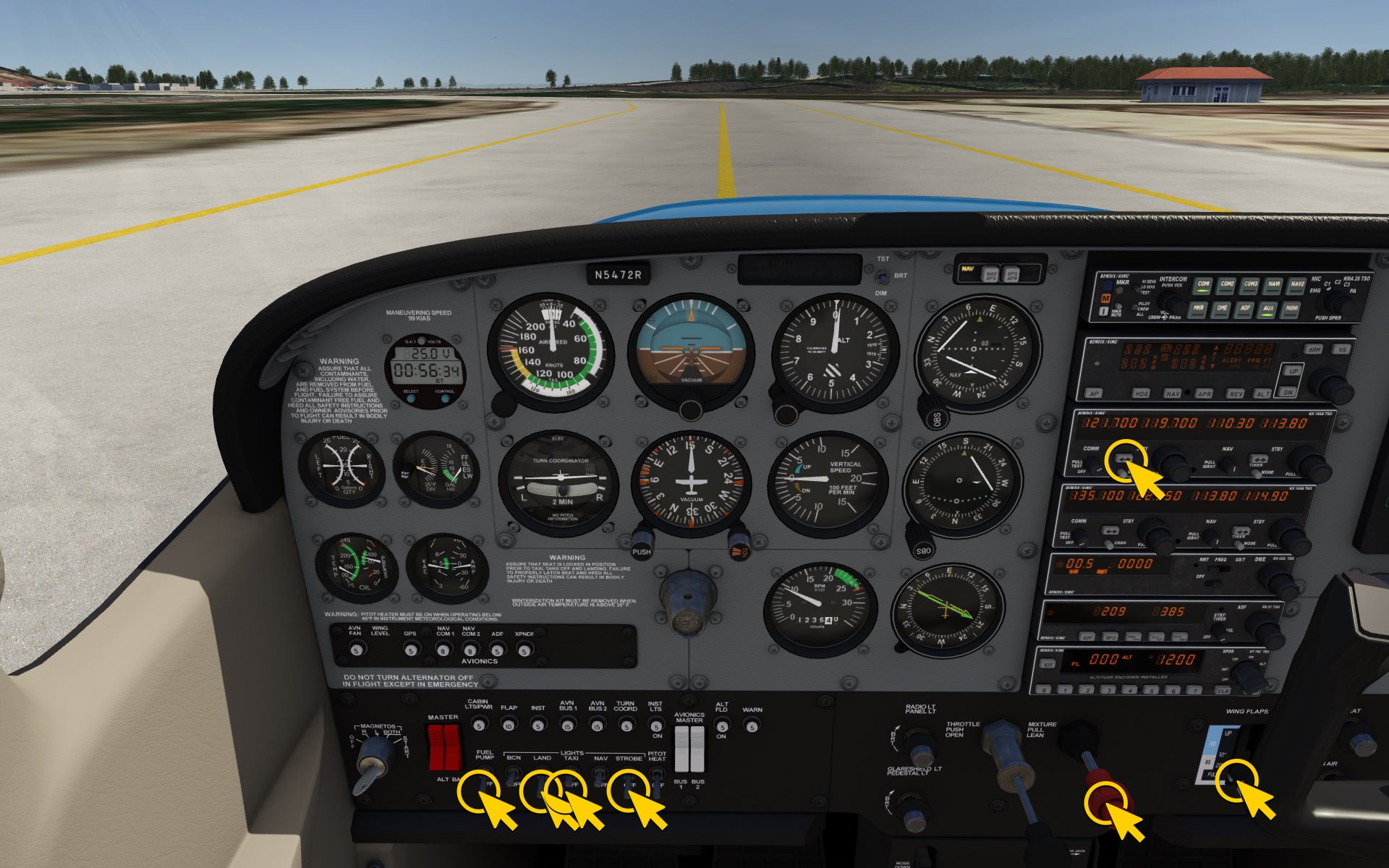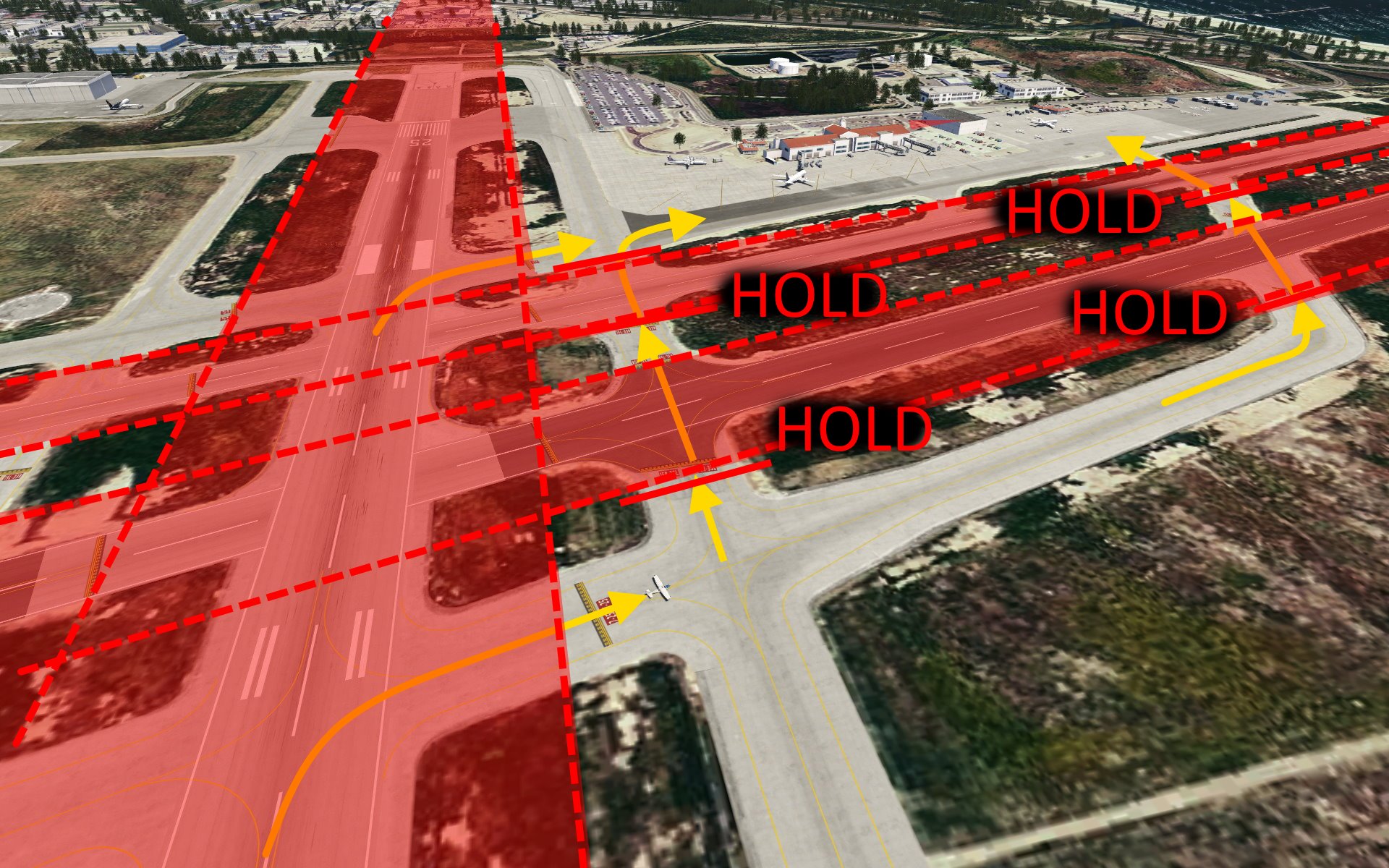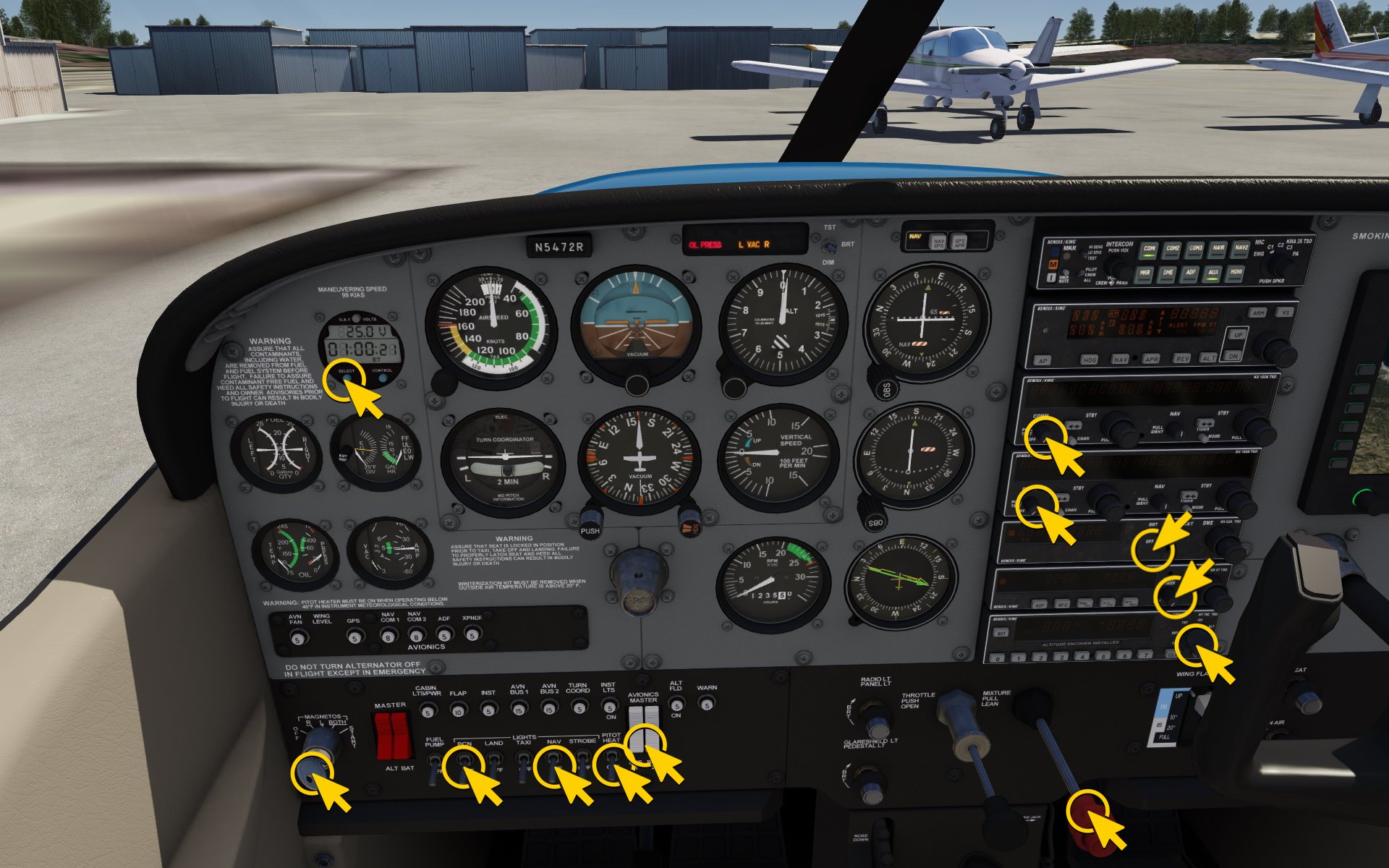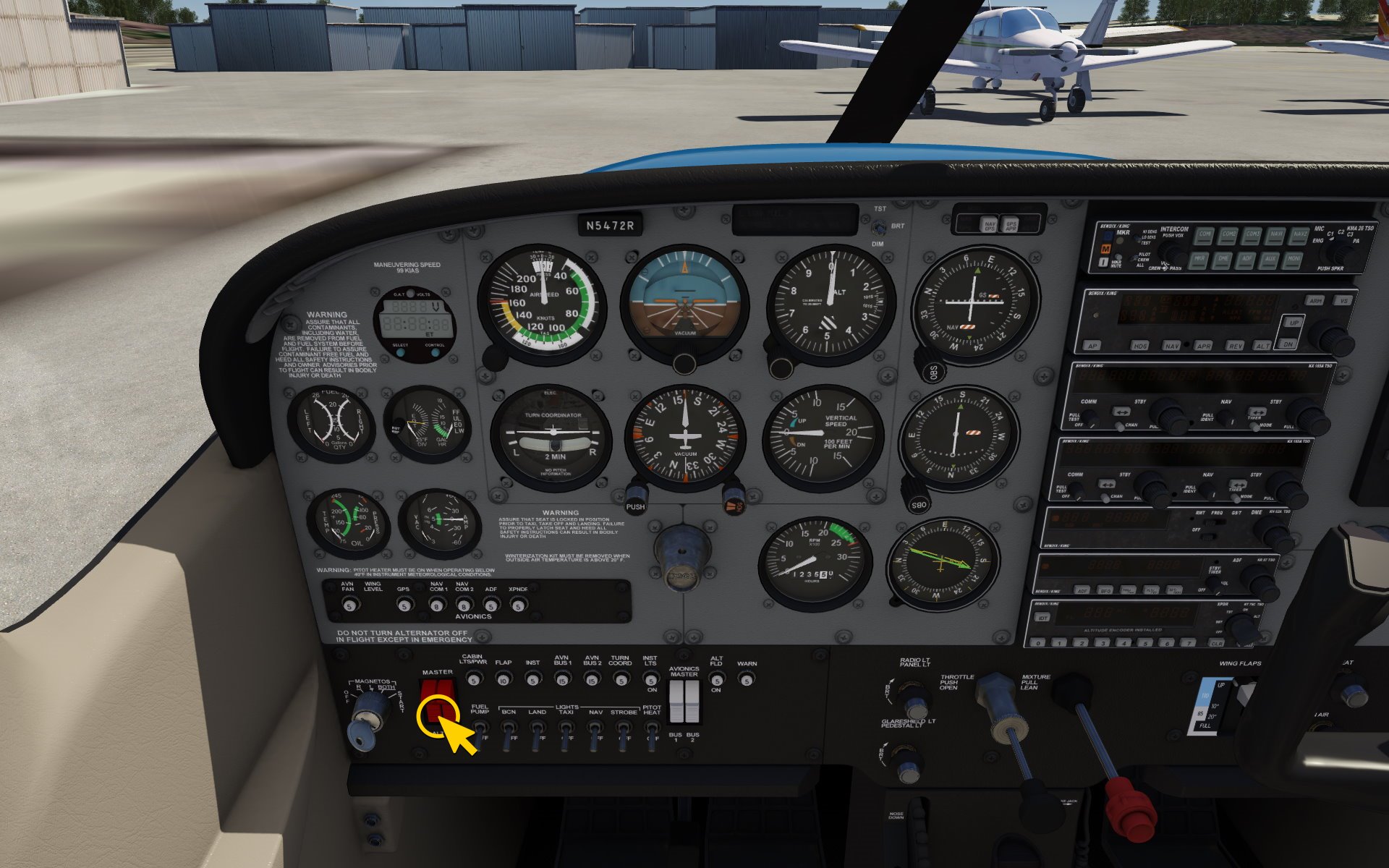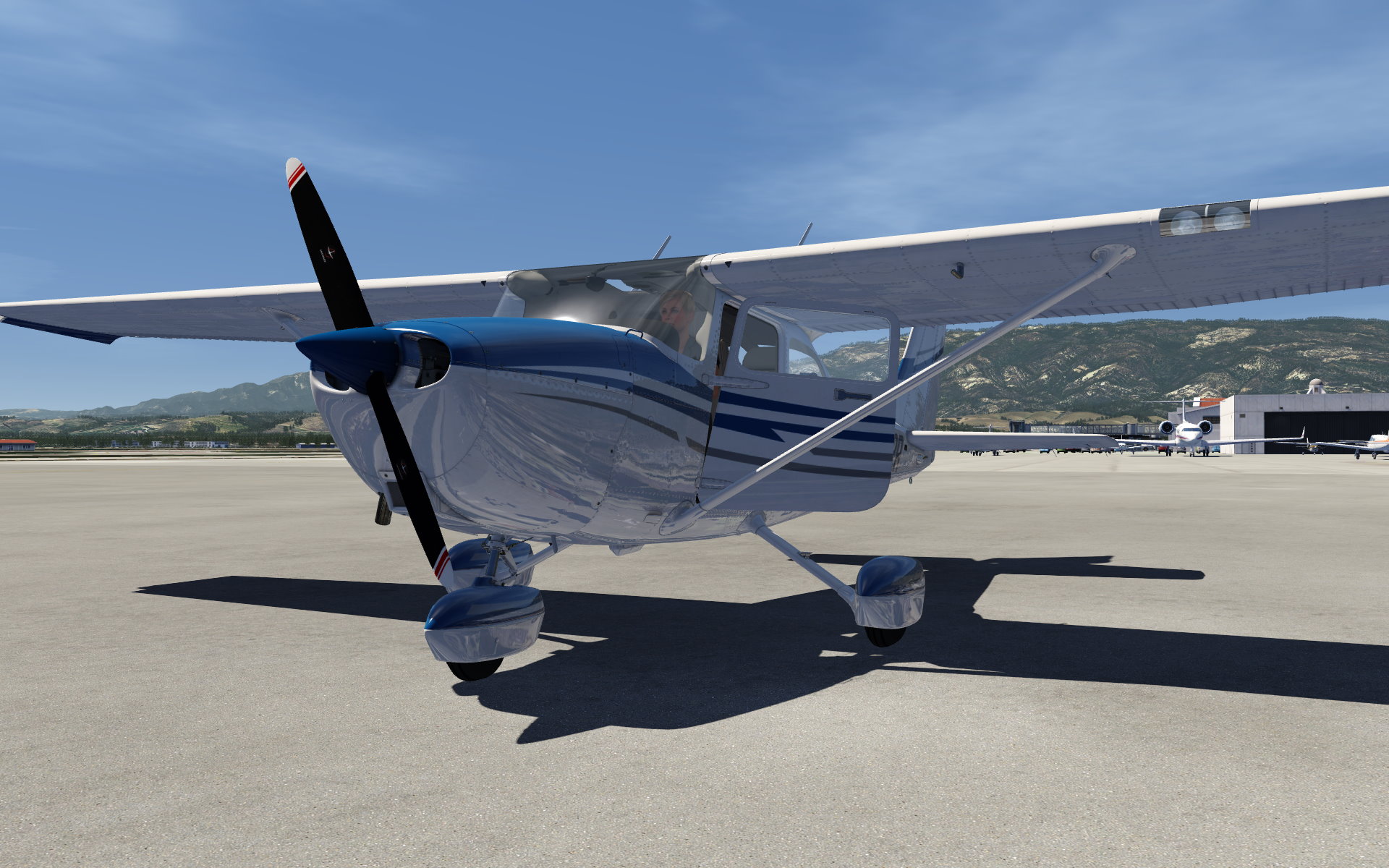Table of Contents
**REDIRECTION NOTICE**
Cessna 172 SP
The Cessna 172 is a very popular training aircraft and because of its high wing configuration it is very stable and forgiving. The Cessna 172 SP features a 180hp piston engine that brings the plane up to around 110 knots in cruise.
Disclaimer
Please don't apply the information that you learned in the wiki in the real world without taking real world flying lessons with a certified flight instructor. We are not certified flight instructors and this tutorial is not intended for real world flying and is applicable to simulator flying only.
Cockpit Introduction
Welcome to Aerofly FS and perhaps your first flight in a Cessna 172.
We're starting this tutorial flight in Santa Barbara (KSBA) on the southern general aviation parking area, in the cold and dark configuration. We're going to introduce you to the basic flight instruments first before we head out for a short local flight around the airport. If you already know all of the instruments you can of course skip ahead.
Looking at the main instrument panel we find the classic six-pack of the most important flight instruments which we highlighted on the screenshot. In front of you you can find the control yoke which is used to steer the aircraft in the air. At your feet you can also find rudder pedals which are used to steer on the ground and to keep the nose pointing straight in the air.
Hiding the Yoke
Behind the yoke you can find all sorts of switches, mainly for controlling the aircraft lights.
- Click at the metallic base of yoke to hide it from view.
- Click that area again to bring it back.
The "Six-Pack"
Let's take a closer look at the most important instruments.
From the top left to bottom right these are:
- Airspeed Indicator (ASI)
- Attitude Indicator (AI)
- Altimeter (ALT)
- Turn Indicator
- Heading Indicator (HDG)
- Vertical Speed Indicator (VSI)
Take your time to inspect the instruments up close. We're not going to explain what each of these instruments do.
Airspeed Indicator (ASI)
The airspeed indicator uses the pitot and static pressure from small openings in the fuselage and on the wing to mechanically compute the speed of the oncoming air. This is the indicated airspeed and is typically measured in knots, giving us a speed in KIAS, knots indicated airspeed.
The more airspeed that we have the more lift the wing can theoretically produce. We usually only need enough lift to compensate the weight of the aircraft when we want to fly straight and level. If we try to fly slower and slower and we will eventually reach a point where the wing cannot generate enough lift and we can no longer fully compensate the gravitational pull. Then we either start descending or if we still try to maintain altitude we will get into a stall situation and the wing will loose even more lift relatively quickly. The airspeed at which a stall happens varies depending on the aircraft weight, the maneuvers that we fly, the flap configuration and many other factors like the current engine power and propeller wash onto the wings. And because of that fact you can't rely solely on the airspeed to stay away from a stall. For the simple case of flying straight and level we can still give some good speed estimates for the airspeed at which the aircraft will stall.
V Speeds
See the wiki page What are the v-speeds? for a detailed explaination.
| Symbol | Description | Indicated Air Speed | Marking on A/S |
|---|---|---|---|
| VS1 | Stall speed at landing configuration | 40 KIAS | Beginning of white arc |
| VS0 | Stall speed at clean configuration | 48 KIAS | Beginning of green arc |
| VR | Rotation speed | 55 KIAS | Not marked |
| VX | Best angle-of-climb speed | 62 KIAS | Not marked |
| VY | Best rate-of-climb speed | 74 KIAS | Not marked |
| VFE | Max flaps extended speed | up to 10°: 110 KIAS | White arc ends at 85 KIAS |
| more than 10°: 85 KIAS | |||
| VC | Typical cruising speed | 90 - 120 KIAS | Not marked |
| VA | Maneuvering speed; Abrupt movement | 105 KIAS | Not marked |
| VNO | Max structural speed | 129 KIAS | Beginning of yellow arc |
| VNE | Never exceed speed | 163 KIAS | Red line |
Attitude Indicator
The attitude indicator consists of three gyroscopes that maintain their attitude relative to the ground reference. The gyros can be driven by electrical motors or by a small vacuum pump attached to the engine, depending on aircraft panel configuration. Our Cessna 172 is uses a vacuum driven system.
The gyros remain in a fixed attitude while the aircraft rotates around it. Attached to them is a symbolic picture with a white horizontal line to represent the horizon, a blue sky part above and a brown earth color for the ground. You can also see several lines marking the pitch angles and bank angles to be able to read these angles in degrees.
Thin white horizontal lines mark the pitch angles -5°, -10° and -15° and thin horizontal black lines mark the pitch angles +5° and +10°.
White diagonal lines at the on the brown earth part show the 22.5° and 45° bank angles. The white dashes at the top of the instrument indicate the bank angles 0°, 10°, 20°, 30°, 60° and 90° for left and right turns.
The image above shows the the following situations in flight.
Top left - A climb with 10° nose up pitch.
Top center - A descent with 10° nose down pitch.
Top right - A climbing right turn with 5° pitch up and 20° bank angle to the right.
Lower left - A level turn to the left. 0° of pitch and 30° bank to the left.
Bottom center - A steep turn to the left with 45° bank angle.
Bottom right - A steep turn to the right with 60° bank angle and 5° nose up pitch.
Altimeter (ALT)
The altimeter is a diagram that expands and retracts as the ambient air pressure changes. It compares the pressure difference of the currently measured air pressure to a reference pressure set with an adjustment knob. The altimeter doesn't show the altitude above sea level or above ground correctly unless it is calibrated to the current air pressure on the ground or sea level.
- Rotate the pressure setting knob in the lower left corner to adjust the reference pressure of the altimeter, indicated on the right hand side in hekto-pascals.
The correct pressure setting is given by local weather stations, automatic terminal information service (ATIS) or automated weather observing system (AWOS). In standard conditions the pressure is 1013 hPa or 29.29 inches of mercury.
The altimeter indicates the pressure difference between the set ground pressure or sea level pressure to the currently measured static air pressure. It shows the derived altitude with three needles.
The longest and thinnest needle with the triangle at the end shows the altitude in ten thousand feet increments.
The short and thick needle shows altitude in 1000 feet increments.
The long and thick needle shows increments in 100 feet.
To read the altitude correctly you have to combine these three needle indications in your head. First you read the 10k needle. In our example it shows roughly 0.4 something which is well below the '1' on the scale, so we know we're roughly at 4000ft but well below 10,000 ft and we can ignore the 10k needle in our calculation.
Then we read the second needle, which in our example indicates 3.8 something. So we know we're somewhere close to 3800ft.
Lastly we read the third needle which shows 8.2 something so 820ft.
Combine all three needles: 0 x 10000ft + 3000ft + 820ft = 3820ft
Turn Indicator
The turn indicator consists of an airplane symbol and a balance ball suspended in water or other fluid types.
When the airplane wings are horizontal then the airplane is not turning at all. When the left wing tip tips down to the white marker then you are flying a turn to the left at standard rate which completes a full 360° turn in two minutes. A 180° turn will take 60 seconds and a 90° turn takes 30 seconds at that turn rate.
These standard rate turns (2 minutes for a full circle) are used in instrument flying conditions to fly standard procedure turns which can be flown relatively precisely even with this one basic instrument.
Internally the turn indicator is another gyroscope that it allowed to tilt depending on the change in heading. As the nose of the airplane yaws left and right the turn indicator shows the rate of turn of the fuselage as seen from above.
The turn indicator does not shot the bank angle of the plane and it also does not show any pitch information. These can be found on the instrument directly above it, the attitude indicator.
The second and lower part of the instrument is the balance ball. This acts just like a balance scale but the tube is slightly curved upwards to the end to make it less sensitive. The ball inside the tube will be pulled down by the acceleration of the airplane and rolls to the lowest point. When we always point our nose straight into the wind the ball will be centered even if we fly turns. It is the equivalent of the forces that you feel when you sit in the airplane yourself.
When the airplane nose is not pointing straight into the wind the fuselage and vertical stabilizer as well as the propeller all will create a side forces. Sitting in the plane we can feel that we are pushed to left and right. The balance ball then also deflects left and right. To correct this we should apply rudder input to straighten out the airplane nose. Otherwise we generate extra drag and worsen the experience for passengers. Thinking of bigger airliners you can imagine it would be very uncomfortable if the flight attendant's trolleys suddenly move left and right and bump into the passengers right next to it. Similarly in a small airplane you don't want all of your passengers and luggage to be flung to one cabin side like they do in a car. Unlike a car the airplane is sensitive to being loaded asymmetrically and would start to roll slowly in an uncommanded fashion.
Looking at the ball, if you see it deflected you should push more of the rudder pedal where the ball is on. If the ball is on the left you apply left rudder with the left foot. When the ball is right of center you push right rudder with the right foot.
You can “kick the ball” back to neutral with your feet.
Heading Indicator
The heading indicator is a gyroscope that maintains its attitude even if the aircraft turns around it. You can think of the compass rose being stationary while the aircraft symbol turns with the actual airframe.
The heading indicator therefor shows the direction of the aircraft nose relative to the fix gyro reference. The gyro is adjusted to the known runway heading before taking off and during the flight it can also be re-calibrated using the magnetic compass on the windscreen.
Aerofly FS manages this calibration for you and the heading indicator shows the correct magnetic heading for you.
The heading indicator has a small heading bug that can be adjusted with the knob in the lower right corner
- Turn the heading knob to adjust the selected heading. This serves as a steering target for the autopilot and can also be used as a reference for manual flying.
Vertical Speed Indicator
The vertical speed indicator shows the rate of climb and rate of descent by comparing the current air pressure with the pressure inside a pressure vessel. The air is allowed to flow in and out of this chamber and the needle moves according to that airflow.
With the needle at zero the aircraft is neither climbing nor descending. You are maintaining altitude for the moment.
When the needle deflects up then you are climbing. It shows the rate of climb in 100 feet per minute. With the needle pointing at +10 for example you are climbing at 1,000 feet per minute. Climbing from 2,000 ft to 4000 ft will take two minutes at that rate.
If the needle is pointing down you are descending and loosing altitude. For approach and landing as a rule of thumb you can use your airspeed in knots and divide that by 2 to give you the necessary sinkrate indication for a stable 3° approach angle. For an approach speed of 70 knots in our Cessna this yields roughly 350 ft/min. For 80 kt it's 400ft/min and for 100 kt it's 500ft/min. The actual rate required depends on other factors like wind speed and actual ground speed but this is a good estimate.
This concludes the basic six most important instruments on the Cessna 172.
Engine
Next, let's talk about the engine in the Cessna 172 SP. The Cessna 172 SP in Aerofly FS has a fuel injection piston engine. The mixture of air and fuel is ignited by spark plugs.
Throttle
The engine is throttled with a black throttle lever in the center of the panel. This adjusts the amount of air and fuel that enter the pistons and the engine power changes.
- Push the throttle lever in to open the throttle and increase engine power. This is like stepping on the gas pedal in a car but here you don't have to stay on the throttle, it stays where you left it.
- Pull the throttle lever out to close the throttle and decrease engine power. The engine should keep running even with the throttle fully closed, similarly to your car engine.
Increasing the engine power will help us accelerate and fly faster or climb. Decreasing the engine power helps us to slow down and causes us to descent.
Mixture
The ratio of fuel to air can be fine tuned with the red mixture lever in the cockpit to adjust the engine to the environmental conditions for maximum power output or for best fuel economy.
- Push the mixture lever in to enrichen the fuel mixture. More fuel goes is mixed in and engine power increases while at sea level.
- Pull the mixture lever out slowly to lean the fuel to air mixture. Less fuel is introduced into the engine. At sea level the engine then produces less power but can be more efficient.
- Pull the mixture out completly to shut the engine off. Without any fuel the engine starves and the engine is savely shut down. After that the magneto switch is turned to OFF to prevent any spark ignition.
Ignition - Magnetos
The spark plugs which ignite the fuel receive their electric power from two rotating magnets attached to the driveshaft that induce a current in electric coils near them. When the engine is rotating these magnetos cause the spark plugs to fire. In the cockpit we can open the two electric circuits (one for each magneto) to stop the engine ignition for each side individually. The ignition key can be found in the lower left of the instrument panel and has multiple stops.
- Off - Turns both magneto switches off. The engine stops but it may still have fuel inside which could potentially ignite and spin the propeller abruptly. To savely shut down the engine you first pull out the fuel mixture, then turn off the magneto switch.
- R - Only the right hand side magneto circuit is closed and the engine can continue to run. The left one is disabled. This position is used to test the right hand side.
- L - Only the left side is closed. The right one is disabled. This position is used to test the left hand side.
- Both - This position is used during the entire flight to have dual redundancy. Even if one circuit were to fail the engine can keep running as long as there is fuel reaching the engine.
- Start - Both magnetos are engaged and the electrical starter is energized. This spring loaded position is used to start the engine and the ignition key is released right after the engine starts. This works the same as in your car.
Engine RPM
The engine rotation speed can be monitored on the engine tachometer which shows the engine's revolutions per minute (RPM). On the same instrument you can also see the total time that the engine has been running, similar to the total mileage indication in your car.
With maximum power, on the ground the engine usually reaches up to 2500 RPM. In the air we may have to reduce the throttle slightly to stay below the red-line limit of 2700 RPM above which we could damage the engine and/or propeller.
On the ground we aim to keep the rotation speed above 1000 RPM to keep it running smoothly and to provide enough generator power to charge the battery. At the full idle position the generator doesn't output enough power to and you can run the risk of draining the battery.
Propeller
Our Cessna 172 SP has a rather simple fixed pitch two blade propeller. The piston engine drives this propeller directly.
Flaps
Behind the right hand yoke you can find the flap lever. This lever selects the desired flap positions: up, 10°, 20° and 30°. The more flaps you have the slower you'll be able to fly. With extended flaps you can't fly as fast because the drag is high and because you could also damage the flaps at high speeds. Because of the additional drag you will need more power and you cannot climb as steep and not as quickly.
- On touch devices simply hold the finger down on the flap lever and slowly move it down to extend flaps.
- With a mouse you can either hold down the left mouse button and move the mouse down OR just use the scroll wheel
- With VR hands you can grab the lever and move it with your virtual hands.
Parking Brake
On the ground, if we don't want to push the left and right foot on the rudder's break pedals all the time we can use the parking brake. The parking brake is a lever under the front panel between the knees of the pilot.
- Click on the lever to set the parking brake. The lever can be pulled out with VR hands.
- Click the lever again or push it forwards to take the parking brake off.
Pitch Trim
In the center, below the front panel you can find a large wheel. This trim wheel is rotated in the direction that you want the airplane nose to move. By rotating this wheel you can deflect a small aerodynamic trim tab on the elevator that alleviates the control yoke elevator forces.
You'll need to trim the aircraft after you increased the speed or when you changed the engine power setting.
- Grab the wheel with your mouse cursor or use the mouse wheel to rotate it.
- With a touch device you can just swipe the wheel with your finger.
- With VR hands you can grab the wheel and spin it and also move it by touching it with the virtual finger and moving the hand.
Fuel Pump
The electric fuel pump increases the fuel delivery pressure to the engine. This ensures a continuous fuel delivery even during abrupt maneuvers on the ground. The fuel pump is turned on before takeoff and can be turned off during flight to save wear. Before landing it is turned on again and can be turned off after safe landing. The fuel pump switch is located on the front panel in the electric switching panel often hidden by the pilot's yoke.
- Hide the yoke if necessary by clicking on the silver base of the yoke.
- Set the fuel pump switch before takeoff or landing to on by clicking on it or by using the mouse wheel.
Fuel Selector
The fuel pump delivers more fuel than the engine needs. The excess fuel is returned to only to the right hand fuel tank which means the left one empties a bit quicker over time. Because this could cause a significant imbalance over time you can turn off the fuel delivery from the emptier tank and only use the most fullest tank. When enough fuel has been consumed so that the imbalance no longer exist you can turn the fuel selector back to both, enabling both fuel tanks to be used.
- Grab the fuel selector and move it to the left position to use the left hand fuel tank.
- Move it to the center “BOTH” position to use left and right fuel tanks simultaneously.
- Move it to the right position to enable only the right hand fuel tank.
Fuel Shut-Off
The fuel shut of valve is positioned near the fuel selector.
- Pull the lever out to stop fuel delivery to the engine. The engine will eventually starve and shut down after it's small feeder tank has been emptied.
Electrical Switches
Behind the pilot's yoke there are many switches that control electric systems on the aircraft.
Remember you can click on the base of the yoke to hide it!
- MASTER BAT - The red switch turns on the battery and provides electricity to essential systems.
- MASTER ALT - The alternator is the engine driven electric generator. When the engine is running it provides electric power to charge the battery and to the systems. Turning it on sets the master battery switch to on as well. Turning it off disables the generator power and the battery starts discharging.
- AVIONICS MASTER 1/2 - Turns avionics devices on/off.
Pitot Heat
In a cold environment ice could form on the leading edge of the wing and on the exposed tip of the pitot tube. Blocking the pitot intake freezes the pressure in the tube and airspeed indication becomes unreliable and shows erroneous readings when the altitude is changing. To prevent ice build up the pitot probe can be heated which melts any ice.
- In visible moisture and below 10°C or 50°F you should turn on the pitot heating.
- Click the switch to turn the pitot heat off.
External Lights
The exterior lights of the Cessna 172 are all controlled from the switches behind the pilot's yoke.
- Click a switch to toggle it on or off OR
- Rotate the mouse wheel to set the switch OR
- Flick the switch with the virtual hands index finger.
The light switches from left to right control:
- BCN - The red beacon light. This warns people on the ground that the aircraft propeller is rotating and the aircraft could start moving at any time.
- LAND - The landing light switch controls a bright white light on the leading edge of the wing that illuminates the runway and is clearly visible from the front. The traffic controller and other aircraft on the ground can easily see you this way during your approach or when you roll down the runway during takeoff and landing.
- TAXI - Turns on the taxi lights which are located right next to the landing lights but are not nearly as bright. These lights illuminate the taxiway in front of you and are visible by other airplanes or vehicles moving on the airport.
- NAV - The navigation lights are a set of three lights. On the left wing you have a red light, on the right wing you have a green light and on the tail you have a white light. These lights are used to indicate the flight direction. When you see a steady red light moving you know the traffic is moving from right to left. When you see a green light it's moving left to right. When you see a white light it's flying away from you and when you see red and green the airplane is flying directly towards you. You don't have to turn these on at daytime.
- STROBE - A bright white flashing strobe light on each wing tip indicates a fast moving aircraft which is easy to see even when the traffic is below you and otherwise hidden in front of millions of city lights. Strobe lights are turned on when entering the runway before taking off and turned off after landing when vacating the runway.
Internal Lighting
Two rotary knobs control the brightness of the radio/panel integrated lighting as well as the glare-shield/pedestal flood illumination.
- Use the mouse wheel to adjust the internal lights.
- With VR hands grab the knob and rotate your hand
- On touch devices tap on the knob, a green ring appears. Move your finger on the green ring around the knob to turn it.
COMMs
Communication with the air traffic controller and with other airplanes in the vicinity is done via radio signals. Air traffic control frequencies can be obtained from airport charts and public databases.
To tune a communication frequency in the Cessna 172 we first have to dial in the frequency and then activate it.
- Rotate the small and large knobs on the COM1 panel to set the desired frequency.
- Push the swap arrow button to transfer your entry to the active frequency to tune the transceiver.
NAV1/NAV2
The Cessna 172 has two separate navigation receivers: NAV1, tuned with the upper radio panel and NAV2, tuned with the lower panel. These receivers are able to pick up signals from VOR or ILS ground stations used for instrument navigation in low visibility.
- On the right side of the upper COM/NAV unit rotate the large and small knobs to set the standby navigation frequency.
- When the desired frequency has been set push the swap pushbutton to transfer the frequency to the active side and to tune the nav receiver.
When within range the course deviation indicator shows a neeedle deflection, otherwise it shows red OFF flags.
DME
The distance measurement equipment (DME) sends a signal to the ground station and then measures the time it takes for the signal to be send from the ground station back to you. Knowing the speed at which the radio waves travel, the speed of light, the distance to the station can be computed from the time delay.
ADF
The automatic direction finder (ADF) is a device that can detect where a radio beacon is coming from. It only shows the direction to/from the station and doesn't provide any distance information.
- Turn the knobs on the right hand side to set the standby ADF frequency
- Push the FREQ/Swap button to activte the frequency.
Transponder
The transponder is a device that sends the aircraft identification and altitude to the air traffic control ground receivers. ATC can then identify you on their radar screen and provide accurate instructions or assistance.
The transponder is usually turned on before taking off and turned off after landing unless otherwise required for tracking aircraft during taxi at larger airports.
ATC assigns each aircraft a certain squawk code. The pilot enter this code into the transponder and when instructed activates the identification function which highlights the airplane on the ATC radar screens.
- Enter the four digits code by pushing the buttons at the bottom.
- Use the clear button to remove the last digit if you typed the wrong digit.
- Push the VFR button to set the code 1200 or 7000 depending on the region's general code.
To set the transponder mode from off to ON or to ON&ALTitude reporting
- Rotate the knob on the right to ALT to send all required data to ATC.
- Set the mode to SBY (standby) to disable the transponder but to keep the device screen on. The transponder is then no longer transmitting and ATC can no longer identify you on the radar screens (their radars may show an unknown aircraft).
- Set the knob to OFF to turn the transponder off completely.
Autopilot
The Cessna 172 SP features a basic autopilot that can be used to fly a certain heading, capture a VOR or ILS or capture and maintain a selected or the current altitude and more.
Please read the Basic Autopilot wiki page on how to use this autopilot.
Flight
From Cold and Dark
We're starting our tutorial from the Santa Barbara Municipal (KSBA) airport which is located North-East of Los Angeles.
- Set the wind to calm or a slight wind from the East. We've set the conditions to clear sky and maximum visibility. But you can deviate from this as you like.
- Select the cold and dark start option if you wish to do the full start up procedure with us.
- Click on the silver base of the yoke to hide it.
- Rotate the fuel selector to BOTH
- Set the fuel cut off to RUN (forward position)
- Look at the fuel level indicators on the left hand side of the panel and make sure that we have enough fuel on board for the planned trip. We'll only need a few gallons but if you're not sure it's always a good idea to top of the fuel. There is nothing worse than fuel left on the ground.
- Set the battery master and alternator master switches to ON.
- Set the fuel pump to on
- Move the mixture lever to full rich
- Move the throttle lever forward slightly, about 10% or so
Engine Start
Let's start the engine.
- Set the beacon light switch to ON.
- Start the elapsed timer on your clock to keep track of the total time that the engine is running.
- Shout “clear” if you want to… but too loud, otherwise you may make the neighbors jealous.
- Rotate the magneto key to START and hold it for a second. This may require continuous scrolling with the mouse wheel or continuous rotation on the green circle overlay for touch devices.
The engine should fire up and the rotation speed should stabilize.
- Adjust the throttle to keep an engine speed of 1000 RPM.
Check the engine instruments on the left. The engine oil pressure should be in the green, we'll have to wait a bit to see the oil temperature rise. We'll have to warm the engine up for a while before taking off.
Check the engine vacuum pressure. It should be in the green, which powers our attitude indicator and our heading indicator gyros.
Check that the Ampmeter shows a positive current or just slightly negative current. Increase your engine RPM briefly to verify that the generator is providing enough power.
Check that the fuel flow and EGT are indicating something and are not stuck.
After Start
- Lean the mixture slightly by pulling the red mixture lever out a bit.
Let's turn on the avionics to be able to navigate the airplane.
- Turn on both avionics master switches
- Turn on all the radios and ADF by rotating their volume knobs right, turn on the DME and set the transponder to standby.
- Check that the attitude indicator displays a wings level attitude
- Adjust the altimeter pressure if needed. Check that the altimeter shows the expected field elevation.
- Verify that the heading indicator is showing the same heading as the magnetic compass on the front window.
- Adjust the heading bug on the heading indicator to the takeoff runway direction.
- Set the selected course for the NAV1 with the OBS1 knob to the takeoff runway direction as well.
Let's perform the flight controls check. This has to be performed on any airplane and should be done before each takeoff. The last thing we want is finding out that we cannot control the plane once we are in the air. If we can find the error on the ground we just taxi back to the hangar or turn the aircraft off and get a vehicle to tow us back.
- Move the ailerons through their full range of travel, from full left to full right and back. Look at the wings and verify that when you rotate the yoke to the left that the left aileron is going up and that the right one is going down. Verify that when you rotate the yoke to the right that the right aileron is going up and the left one is going down.
- Move the elevator from to full up, then full down. Look back over your shoulder to verify the direction of movement.
- Move the rudder full left and full right and check that through the rear window as well.
- Set the pitch-trim for takeoff (and all other trims to zero but the Cessna 172 only has pitch trim)
Taxi
We're now taxiing to the run-up area for the runway 07 takeoff. We'll have to cross two other runways to get there. Before crossing them we have to stop at the yellow hold short line and check in both directions for any traffic on the runway or on the final approach. We have to do this twice during our taxi.
- Turn on the taxi light to show other airplanes and personnel on the ground that we're starting to move.
- Hold the brakes by depressing the rudder pedals. Per default you can use the key 'B' on your keyboard or if you are on mobile you can hold the throttle slider down in the brake area.
- Release the parking brake by clicking the black parking brake lever under the front panel. Caution! The plane will start rolling immediately unless you are holding the brakes.
- Use the left and right rudder pedals to steer the plane left and right on the ground. Even though the yoke looks like a steering wheel it does literally nothing during the taxi phase on the ground.
Taxi to the run up area next to runway 07. There we can test our engine without causing too much wind from our propeller wash.
- Point the nose into the wind and stop the plane with the brakes.
- Set the parking brake.
Run-Up
We're now performing an engine test before we take off. Make sure the parking brake is set. In the real world you would probably still depress the brake pedals if there is an obstacle or other plane in front of you.
Before this test check that the engine oil temperature has risen and is within the green area. Otherwise hold your position and increase throttle slightly to warm up the engine first.
- Set parking brake and turn the taxi light off.
- Set the mixture to full rich by moving the red lever full forward.
- Increase throttle to increase the engine rotation speed to 1700 RPM.
- Check that the engine runs smoothly.
- Check that the engine oil temperature and oil pressure are within the green area.
- Check the suction pressure and ampermeter.
- Check the engine EGT and fuel flow
- Check that you have enough fuel on board for the planned mission.
Let's test the two ignition circuits of the engine
- Set the engine magneto switch from BOTH to the LEFT position. The rotation speed should only drop slightly by a maximum of 150 RPM. The engine should continue to run smoothly. Otherwise the left magneto has a problem and we should fix this issue on the ground.
- Set the engine magneto switch back to BOTH and let the RPM stabilize at 1700 RPM again.
- Set the magneto switch to RIGHT. Check the RPM drop is within limits again.
- Set the magneto switch to BOTH.
Now we're testing the engine idle.
- Reduce throttle to full idle.
- Check that the engine keeps running and doesn't stall.
Run-up check complete
- Set 1000 RPM again.
- We're planning to takeoff very soon so we keep the mixture at full rich for takeoff.
- Turn the taxi light back on and release the parking brake once you are ready to continue the taxi.
Before Takeoff
- Continue on the taxiway and taxi to the yellow hold short line in front of the runway.
- Set the tower frequency in the COM1, which is 119.7 for Santa Barbara.
- Set the fuel pump to ON.
- Set red mixture lever to full rich.
- Verify that flaps are at the desired takeoff position. We keep flaps up for this takeoff.
Line Up
Always check for traffic even if ATC has cleared you onto the runway. Check both left and right.
Once you cross the hold short line
- Turn on the landing lights with the switch in the lower front panel.
- Turn on the strobe lights with the strobe light switch.
- Set the transponder to ALT by rotating the transponder mode knob.
If ATC has given you any heading assignment you should adjust the heading knob to the assigned heading.
- Set heading 075° with the heading knob to set the runway heading at Santa Barbara.
- Verify that the heading indicator shows the same heading as the magnetic compass.
- Check that the runway you are has the correct identifier and that the runway heading matches your indication on the heading indicator.
Takeoff
We're going to perform a normal takeoff with flaps up. The runway has a hard surface, wind is calm. There are no obstacles at the end and the runway is more than long enough for our Cessna. We can even safely abort our takeoff straight ahead in case the engine malfunctions.
We plan on rotating at 50 knots and with slight back pressure the airplane should lift off at 55 knots. After lift off we keep 75 knots.
| Normal Takeoff | |
|---|---|
| Flaps | 0-10 degrees |
| Rotate | 50 KIAS |
| Liftoff | 55 KIAS |
| Climb | 70-80 KIAS |
| Obstacle Takeoff | |
|---|---|
| Flaps | 10 degrees |
| Rotate | 45 KIAS |
| Liftoff | 50 KIAS |
| Clear Obstacle | 57 KIAS |
| Climb | 70-85 KIAS |
| Softfield Takeoff | |
|---|---|
| Flaps | 10 degrees |
| Rotate | Minimum Speed |
| Liftoff | Minimum Speed |
| Flaps | Up at 55 KIAS |
| Climb | 75 KIAS |
- Set full power and add slight right rudder to compensate for the engine torque and propeller wash hitting the vertical stabilizer
- Maintain the runway centerline with the rudder. This will most likely require constant deflection in one direction with only very small adjustment around that offset position.
- Pull up gently at 50 to 60 knots. The airplane should fly off the ground very easily.
- Reduce back pressure slowly and adjust your pitch attitude to maintain between 70 and 80 knots.
- Adjust the pitch trim if needed to stay at the desired speed.
- Turn slightly left or right to stay on the takeoff runway heading.
Once we're above a safe altitude we can engage the autopilot.
- Push the AP button to engage the autopilot. It should show ROL and PIT on the autopilot, indicating that the autopilot maintains the current roll and pitch attitude.
- You can let go of the yoke.
- Engage the heading mode on the autopilot by pushing the HDG pushbutton.
- The autopilot will steer towards our selected heading on the heading indicator.
If ATC has cleared you to a certain altitude rotate the knobs on the autopilot panel to pre-select that altitude.
- Set an altitude of 5000ft in the autopilot pre-selector.
After Takeoff
- Set the flaps to up, which they already should be.
- Turn the landing lights off.
- Turn the taxi light off.
- Turn the fuel pump off.
- Set the fuel selector to the fullest tank. We're going to keep it at BOTH in our tutorial.
Climb
We'll continue our climb at 75 knots.
- Turn right to a heading of 255°, which is a 180° right turn. Use the heading bug on the heading indicator and rotate it clockwise. The autopilot turns the plane right.
- Adjust the pitch attitude by pushing the UP and DOWN buttons on the autopilot panel if needed.
As we climb higher the air is getting thinner. But the engine is still injecting the same amount of fuel which means the ratio of fuel to air is getting too rich.
- Pull out the mixture ever slightly to bring the mixture back to the ideal ratio. This increases the engine power as we climb and improves fuel consumption a lot.
During a descent we have to remember to increase the mixture again to avoid starving the engine.
Cruise
The autopilot levels the plane at our pre-selected 5000 feet altitude. The plane will reduce the pitch attitude which means we will gain speed. We're in control of the airspeed and have to adjust throttle throughout the entire flight.
- Reduce throttle to set a rotation speed of 2400 RPM.
Let's adjust the mixture to get the most economical fuel burn.
- Rotate the knob on the EGT gauge to adjust the orange needle. Set it to the same position as the white actual EGT needle.
- Now pull out the mixture gently. The EGT needle should rise above our set marker.
- Pull out the mixture more until the EGT reaches a maximum and starts decreasing again. Then increase mixture to find the maximum EGT.
- Set your EGT marker to that maximum EGT needle position.
- Then increase the mixture slightly to fly rich of peak.
The EGT won't be as hot as the maximum EGT that can be reach which gives us a slight margin for error.
Instrument Navigation
Let us demonstrate the instrument capabilities of the Aerofly FS Cessna 172 SP. If you want to skip this you can go to the final approach chapter next.
We'll show you how to fly:
- From VOR to VOR
- An ILS approach
But the Cessna 172 is also equipped with a DME and ADF so you can also fly:
- VOR/DME approaches
- NDB approaches
VOR Navigation
We're starting this VOR navigation tutorial after reaching the cruise phase at 5000 feet.
- Turn right to a heading of 090°. This will bring us right above the Santa Barbara airport again,
at 5000 feet. - You can of course also teleport above the KSBA airport to 5000 feet, heading east, using the location menu. Just make sure to select heading 090° and engage the autopilot in HDG mode and capture the 5000 feet altitude.
What is a VOR?
A very high frequency omni-directional range (VOR) is a radio navigation station on the ground that sends out signals in all directions at two different radio waves. Simplified drastically: One frequency is emitted constantly and the other travels around the station in circles. Measuring the time delay between the signals tells you the direction to the navigation station.
The frequencies for these VOR stations can be obtained from the navigation menu of Aerofly FS. Simply click on a station on the map and it tells you the frequency on the right.
We're going to use the San Marcus VOR north-east of Santa Barbara (KSBA) which has the identifier RZS and the frequency 114.90 MHz.
- On the COM/NAV 1 panel set the standby frequency to 114.90 with the knobs on the right
- Push the swap arrow (↔) to activate the frequency
Direct to VOR
The needle on the course deviation indicator (CDI) should now show a needle deflection. The VOR does not provide a glide slope signal, so the glide slope needle is at zero and a red “GS” flag is visible as expected.
- Turn the OBS1 knob and see how the needle moves.
At some point the needle moves through the center, this depends on your position relative to the station. Observe the white arrow at the bottom of the instrument as well. It either shows an up arrow or a down arrow.
With the needle centered at zero and with the white arrow pointing up the instrument tells you which course you have to fly to get to the VOR station. Read the course on the instrument at the top marker of the compass rose.
- Set your heading bug on the heading indicator to that course and turn on the autopilot.
- Push the autopilot AP button to turn the autopilot on.
- Then push the HDG button to fly to the selected heading
- You can also push the NAV button, then the autopilot will fly track the needle deviations and fly you to the station and keep flying in the same direction once you have passed the station.
This is a crude way to fly to a station but helps you to fly around. But we can do even better than that. If you know from which direction you want to fly to the VOR station, e.g. along a valley and not through the mountains on the side you can set the desired course on the instrument and then follow the needle signals to stay on the selected radial.
Radial To VOR
- Fly east at 5000 feet starting from above the Santa Barbara (KSBA) airport again.
- Turn on the autopilot with the AP pushbutton and select a heading of 090° with the heading bug and push the HDG pushbutton on the autopilot. Hold 5000 ft.
- Make sure that the active frequency for NAV1 is set to 114.90 MHz.
- Turn the OBS1 knob to set a course of 360°.
- Observe how the needle first shows a full right deflection. Then it moves towards the middle.
- Push the NAV button to let the autopilot capture the VOR radial and to turn towards the selected course.
When you are above the hills you should eventually fly above the San Marcus VOR station. This hill is around 4000ft so we should pass right over it. Look for the white arrow at the bottom of the instrument. Once you fly over the station it flips from pointing up to pointing down. This indicates that you have passed the station and are now flying away from it.
VOR to VOR
- Set a course of 261° with the OBS1 knob
The autopilot will turn the plane left to 261° and steers us back to the outbound radial of the San Marcus (RZS) VOR. This direction will bring us directly to the next VOR, the Gaviota VOR (GVO).
- Use the COM/NAV 2 panel this time and set the standby frequency of the Gaviota VOR (GVO), which is 113.80 MHz.
- Turn the OBS2 knob to set a course of 261° for the NAV2 receiver.
The autopilot is always following the NAV1 signals and is still flying away from
- Enter the GVO frequency, 113.80 MHz into the standby field of the NAV1 receiver now.
- Activate the frequency by pushing the swap arrow (↔).
- Since the desired radial is the same, we can keep the course at 261°.
Descent
We'll keep flying on this radial for a while. Before reaching GVO we're starting our descent. Look at the DME display. When it's showing about 3 NM to GVO we'll initiate the descent.
- Rotate the altitude knobs on the autopilot panel to select 3500 feet.
- Push the vertical speed button to engage vertical speed mode.
- Push the DOWN button on the autopilot panel to set the vertical speed. Select -1000 feet per minute as the descent rate.
As we descent perform the descent adjust the throttle and enrichen the mixture.
- Adjust throttle to stay at round 90-110 knots.
- Set mixture to full rich.
- Check the altimeter pressure setting
ILS Approach
What is an ILS?
The instrument landing system (ILS) is a navigation systems that is used to fly an aircraft to the runway. The system has two antennae on the ground. One is placed at the far end of the runway and provides lateral (left/right) information. This localizer signal helps you to stay aligned on the runway centerline during the approach. The second antenna is placed next to the touch down zone and guides the aircraft vertically (up/down), typically on a final descent 3° angle. This is called the glide slope.
The selection of the ILS station is achieved by tuning the correct ILS frequency and setting the approach course. The aircraft is flown towards the signal from the runway and the pilots follow the beam down to the runway. Some aircraft like the Airbus A320 or Boeing 747 can even fly the ILS down to touchdown on autopilot. But our Cessna 172 cannot.
For this example we are going to use the ILS RWY 10R at Monterey Regional airport in California, located about 100 NM south of San Francisco. The frequency for this ILS is 110.7 MHz and the approach course is 098°. If you want to fly the ILS for runway 07 at Santa Barbara (KSBA) the frequency is 110.3 MHz and the course is 075°.
You can find these frequencies in the Aerofly FS navigation menu, when you select a runway or the approach for the runway as your destination runway.
ILS Intercept
We're now breaking off from the radial to GVO and fly an intercept heading for our base leg.
- Select a heading of 180°.
- Push the HDG button on the autopilot
- Once the new altitude of 3500 feet is reached increase power again to keep airspeed high.
Arm the ILS Approach
You should be above 3500ft and flying on a heading of 180° at this time.
- Set the ILS frequency for the ILS 07 at Santa Barbara (KSBA), which is 110.30 MHz, in the NAV1 frequency.
- Set the approach course of 075° with the OBS1 knob.
- Push the APPR to arm the localizer and glide slope capture.
ILS Capture
Once the needle starts moving to the middle the autopilot starts to capture the localizer. The autopilot mode changes to APPR. The glide slope engages shortly after.
Once the glide slope captures the autopilot will nose down to stay on glide slope. We're now fully established on the ILS and the autopilot would continue to fly and crash us right into the runway touch down zone. So we always have to perform the last bit of the landing manually in this airplane.
Final Approach
- Adjust the throttle to keep a speed of 90 knots.
- Monitor the deflection of the localizer and glide slope needles. They should be centered.
- Turn the landing and taxi lights on.
- Turn the fuel pump on.
| KIAS at Flap Setting | |||
|---|---|---|---|
| Position in Pattern | 10 deg | 20 deg | 30 deg |
| Downwind | 80 | – | – |
| Base | 80 | 70 | – |
| Final | 80 | 70 | 60 |
When you reach the coast line you can start to slow down to the final approach speed of 65 knots.
- Extend flaps to 10° after checking that the speed is below 110 knots.
- Adjust throttle to slow down to about 70 knots.
- Then set flaps to full
- Set mixture to full (if not already).
The flaps cause additional lift and drag which can throw off the autopilot a bit. Let it stabilize on the glide slope again.
Landing
- Turn the autopilot off and use the yoke and rudder pedals fly to the touch down zone. Aim slightly before the actual touch down zone.
- Adjust the throttle to stay at 65 knots.
- Make small adjustments with aileron and rudder to stay on the centerline.
The precision approach path indicator (PAPI) will guide you vertically. When you see two red lights and two white lights you are on the correct path. When you are too low you will see more red lights than white lights. And if you are too high you can see more white lights than red lights.
Flare
At about 15 ft above the runway reduce the throttle to idle, then gently increase back pressure on the yoke to raise the nose and to arrest the descent rate. Look out and towards the end of the runway. The white runway edge lines move up due to the change in perspective.
- Reduce throttle to idle.
- Pull up gently to raise the nose of the plane.
The distance between the nose of the plane and the horizon should decrease over time. The screenshot below shows the exact moment of touch down, this is the attitude that you should aim for.
After Landing
We've arrived at Santa Barbara. Please vacate the runway to the right at the earliest possible taxiway. Once you have taxied off the runway and you are behind the hold short lines and out of the runway area you can stop and hold the parking brake to do the after landing checklist and to look at the taxi route.
Let's perform the after landing checks first.
- Set the landing lights off.
- Set the strobe lights off.
- Make sure the taxi light is on.
- Turn the fuel pump switch off.
- Set the flaps to up.
- Lean the mixture slightly.
- Set the transponder to standby (SBY)
- Set the standby COM1 frequency to 121.700 and push the swap arrow (↔) to activate the Santa Barbara Ground frequency.
You can take the same route we came from and cross the two runways at the end of the taxiway.
Make sure that before entering a runway that you hold short and look in both directions for any potential traffic about to takeoff or on final approach.
Shut Down
Once you have found a free parking spot
- Set the parking brake.
- Turn off the taxi light.
- Pull the mixture out completely to turn off the engine.
- When the engine has stopped turn the magneto switch to OFF.
- Turn the beacon light OFF.
- Stop the elapsed timer.
- Turn the pitot heat switch OFF.
- Turn all avionics off by rotating their volume knob to the off position.
- Turn the avionics master switches OFF.
- Set the master battery switch to OFF.
You can now open the door and leave the aircraft.
- Click the black door handle to unlock the door.
- Push the door open.
